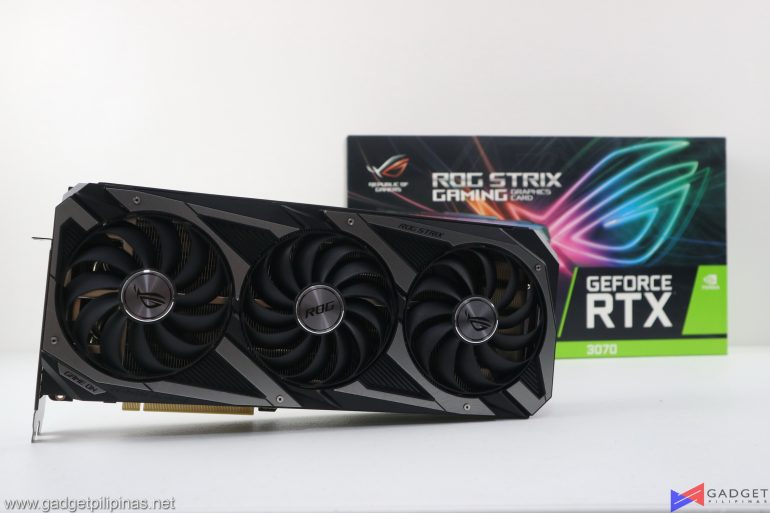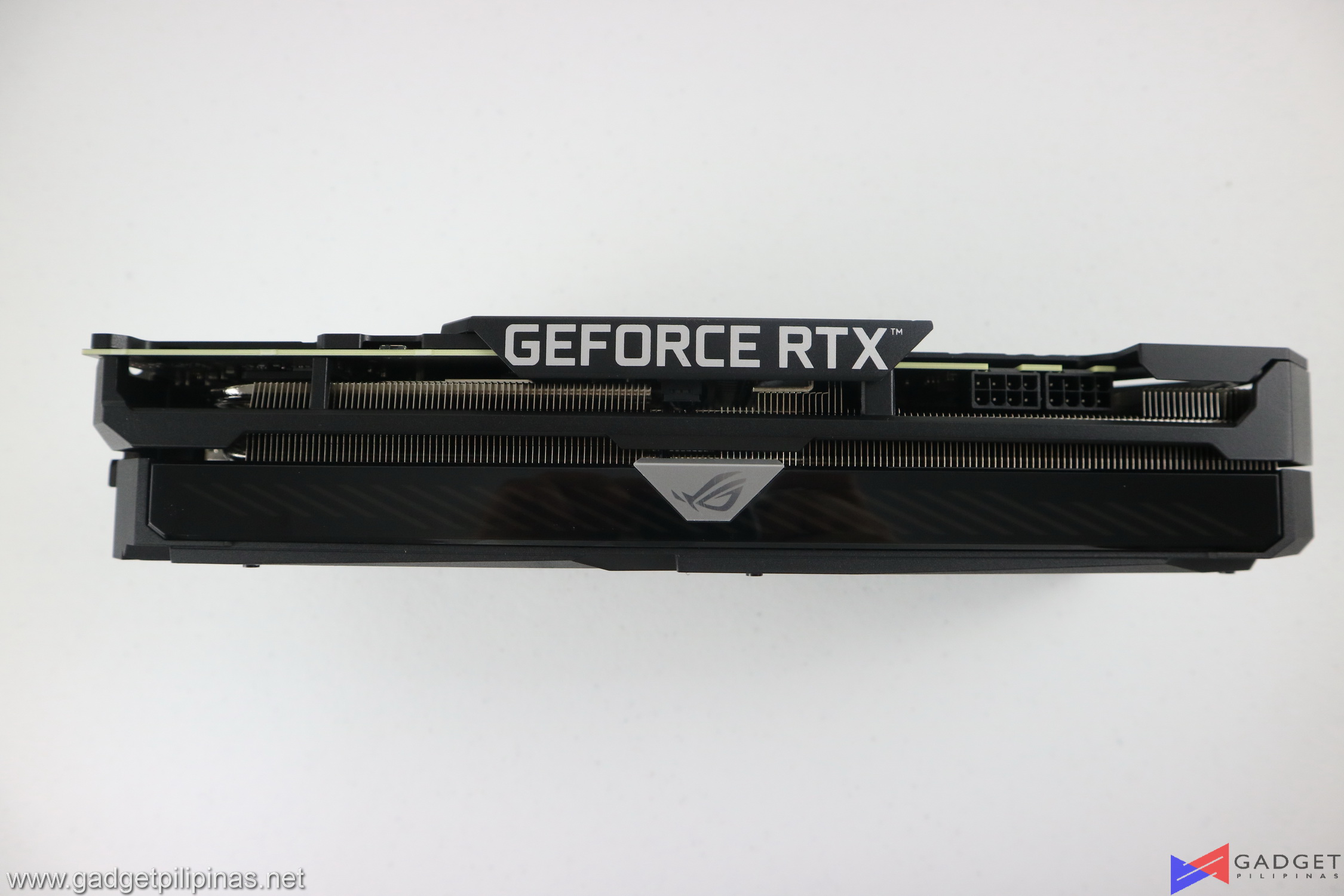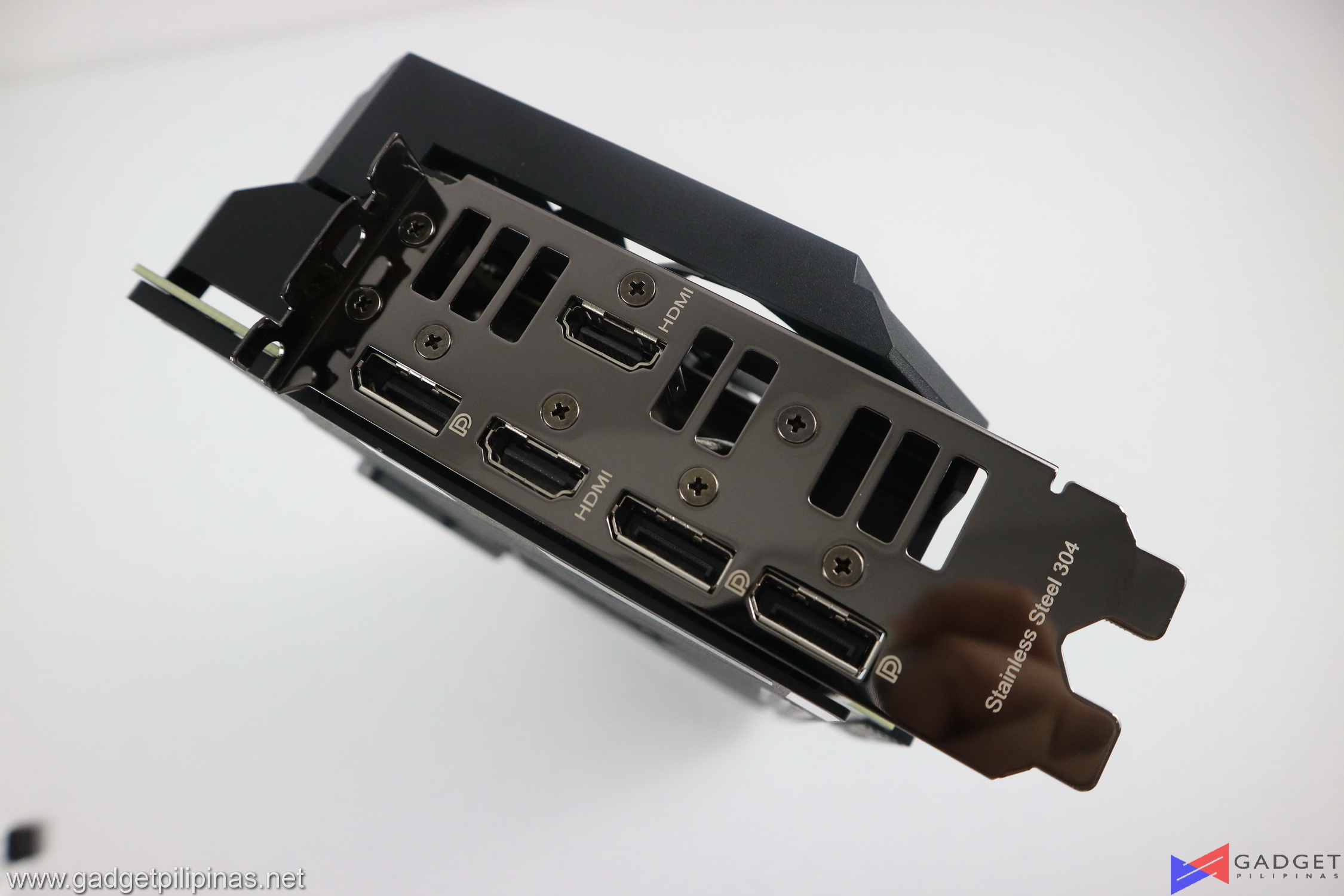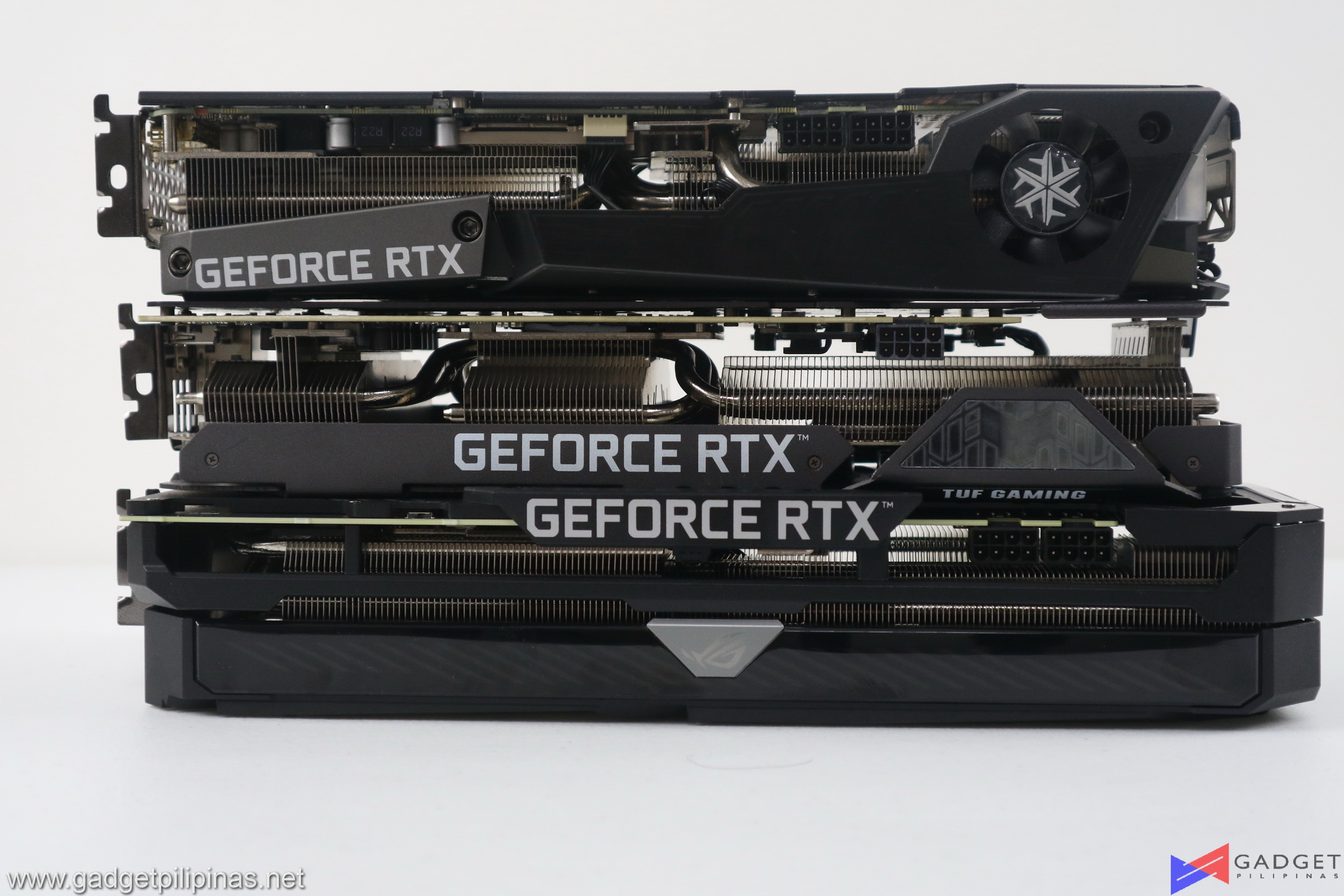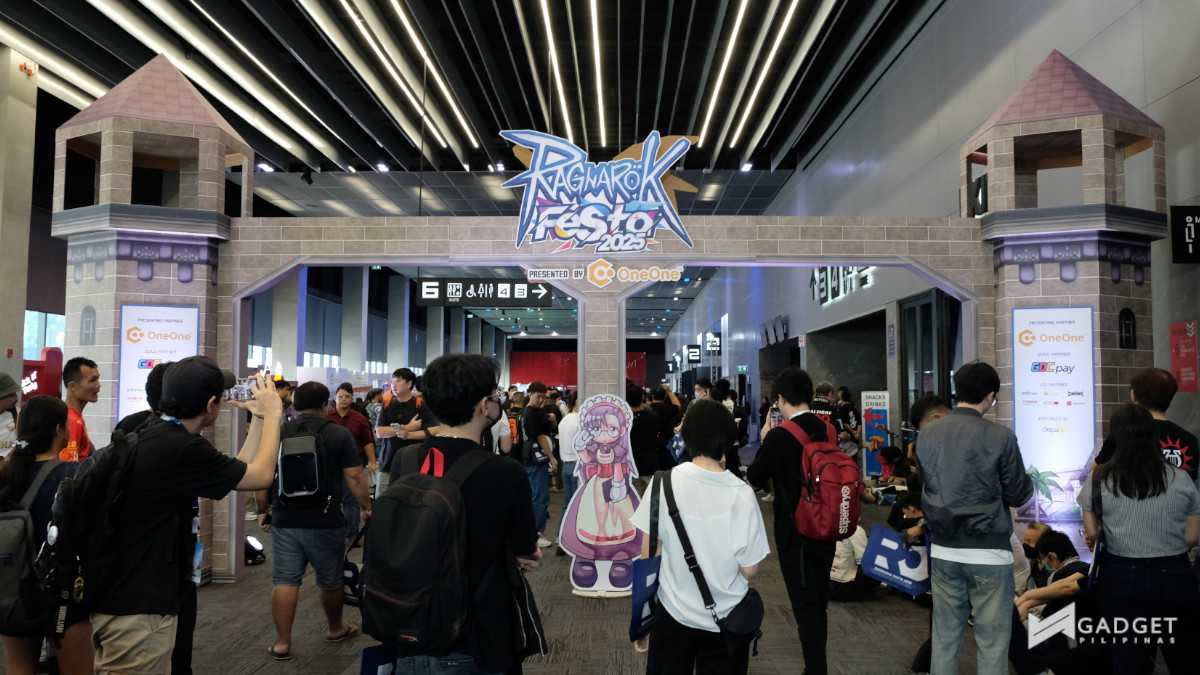Introduction
Almost a year has passed since the Nvidia RTX 30 series GPUs debut, specifically the Nvidia GeForce RTX 3080 and GeForce RTX 3070. Despite the inflated prices that we continue to experience, the RTX 3070 remains the most sought-after GPU for gamers even after the AMD Radeon RX 6700 XT release. Among the RTX 3070 variants selling in the market, the ASUS ROG Strix RTX 3070 OC holds very high praise from gamers due to its robust build quality, thanks to the ROG Strix touchups. We’ll be taking a look at the ASUS ROG Strix RTX 3070 to see why gamers prefer to pay the premium over the regular $499 price stage of other RTX 3070 variants.
Nvidia GeForce RTX 3070 Specs
| Nvidia GeForce RTX 3070 Specs | ||||||
| Graphics Card | RTX 3090 | RTX 3080 Ti | RTX 3080 | RTX 3070 Ti | RTX 3070 | RTX 3060 Ti |
| Architecture | GA102 | GA102 | GA102 | GA104 | GA104 | GA104 |
| Process Technology | Samsung 8N | Samsung 8N | Samsung 8N | Samsung 8N | Samsung 8N | Samsung 8N |
| Transistors (Billion) | 28.3 | 28.3 | 28.3 | 17.4 | 17.4 | 17.4 |
| Die size (mm^2) | 628.4 | 628.4 | 628.4 | 392.5 | 392.5 | 392.5 |
| SMs | 82 | 80 | 68 | 38 | 46 | 38 |
| GPU Cores | 10496 | 10240 | 8704 | 6144 | 5888 | 4864 |
| Tensor Cores | 328 | 320 | 272 | 192 | 184 | 152 |
| RT Cores | 82 | 80 | 68 | 48 | 46 | 38 |
| Base Clock (MHz) | 1400 | 1370 | 1440 | 1575 | 1500 | 1410 |
| Boost Clock (MHz) | 1695 | 1670 | 1710 | 1770 | 1725 | 1665 |
| VRAM Speed (Gbps) | 19 | 19 | 19 | 19 | 14 | 14 |
| VRAM (GB) | 24 | 12 | 10 | 8 | 8 | 8 |
| VRAM Bus Width | 384 | 384 | 320 | 256 | 256 | 256 |
| ROPs | 112 | 112 | 96 | 96 | 96 | 80 |
| TMUs | 328 | 320 | 272 | 192 | 184 | 152 |
| Bandwidth (GBps) | 936.2 | 912 | 760 | 608.3 | 448 | 448 |
| TGP (watts) | 350 | 350 | 320 | 290 | 220 | 200 |
| Launch Price | $1499 | $1199 | $699 | $599 | $499 | $399 |
Specs-wise, the RTX 3070 sits in between the RTX 3070 Ti and RTX 3060 Ti with an almost equal gap in core count and the same $100 difference. All three uses the same GA104 core as the RTX 3070, sporting 5888 GPU, cores, 184 Tensor Corse, and 46 RT cores, twenty percent more than the RTX 3060 Ti. On the other hand, the RTX 3070 Ti has only five percent more cores than the vanilla RTX 3070 Ti, but the Ti variant uses GDDR6X memory, which translates to 19 Gbps VRAM speed. Power-wise, the RTX 3070 only consumes 10% more power than the RTX 3060 Ti for 20% more overall cores and is 70-watts more efficient than the RTX 3070 Ti with 5% more cores and GDDR6X memory.
ASUS ROG Strix GeForce RTX 3070
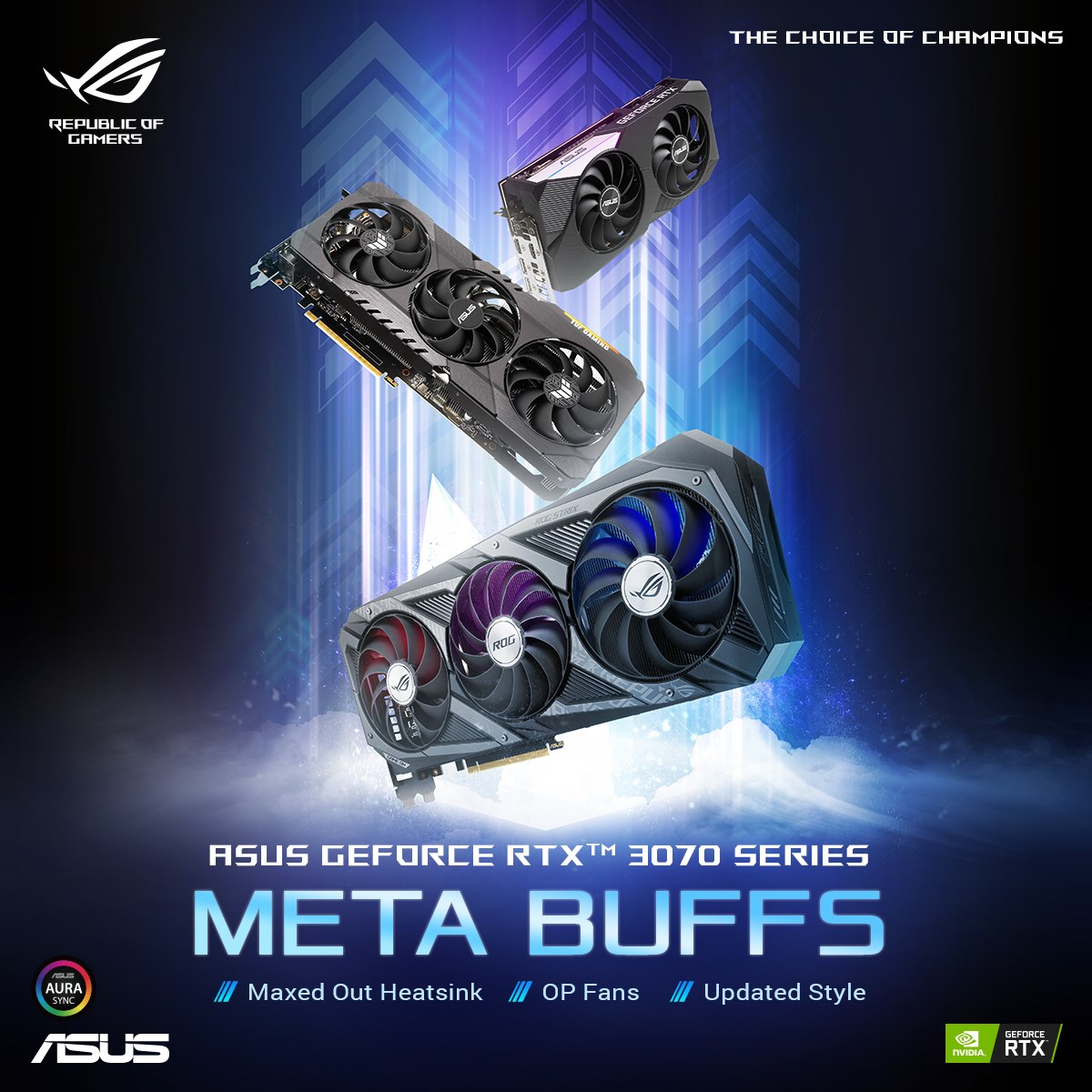 The ASUS ROG Strix RTX 3070 is the flagship model in ASUS’ RTX 3070 series lineup sporting the latest ROG Strix 2.9-slot cooling shroud equipped with axial tech fans. The ASUS ROG Strix RTX 3070 basically uses the same cooler found on the more power RTX 3080 and RTX 3090 series. Being the flagship card in ASUS’ RTX 30 lineup, the ROG Strix variant commands a higher SRP than the ASUS TUF variant with an average price difference of Php 10,000 depending on the store and, of course, the current GPU supply.
The ASUS ROG Strix RTX 3070 is the flagship model in ASUS’ RTX 3070 series lineup sporting the latest ROG Strix 2.9-slot cooling shroud equipped with axial tech fans. The ASUS ROG Strix RTX 3070 basically uses the same cooler found on the more power RTX 3080 and RTX 3090 series. Being the flagship card in ASUS’ RTX 30 lineup, the ROG Strix variant commands a higher SRP than the ASUS TUF variant with an average price difference of Php 10,000 depending on the store and, of course, the current GPU supply.
RTX Technologies Breakdown
The latest Ampere Architecture features 2nd Generation RT Cores and 3rd Generation Tensor cores that double the performance compared to last generation’s Turing architecture and bring in new and improved features such as Ray Tracing, DLSS 2.0, Nvidia Broadcast, Reflex, and many more.
The all-new GeForce RTX 30 graphics cards deliver unmatched Ray Tracing capabilities that further immerse you into games by using ray-traced lighting, shading, and reflection, thanks to the 2nd Generation RT Cores. Real-time Ray Tracing is achieved by tracing the path of light as pixels as well as simulating how these light pixels interact with other virtual objects in the game resulting in incredible visuals.
DLSS or Deep Learning Super Sampling is Nvidia’s proprietary image upscaling technology that uses AI or deep learning to render fewer pixels than uses AI to construct sharp, higher resolution images. Enabling DLSS will give you more framerate at higher resolutions without the loss in image quality.
NVIDIA Reflex is a feature that debuted alongside the GeForce RTX 30 series, but the great news is even older GeForce Graphics cards support Reflex. NVIDIA Reflex reduces overall system latency in GPU-intensive games with the help of the GPU, a G-Sync display, and software. If you’re a competitive gamer or a pro player, then NVIDIA helps you by making your PC respond faster to your keyboard and mouse inputs helping you secure victory.
ROG Strix RTX 3070 Unboxing and First Impression
- ASUS ROG Strix RTX 3070 Review 001
- ASUS ROG Strix RTX 3070 Review 001
- ASUS ROG Strix RTX 3070 Review 002
- ASUS ROG Strix RTX 3070 Review 002
ASUS uses the same ROG Strix style packaging that’s found across all of its products, such as peripherals, monitors, and motherboards. The back of the packaging shows the ROG Strix cooler shroud’s highlights as well as Nvidia Ampere Architecture’s key features.
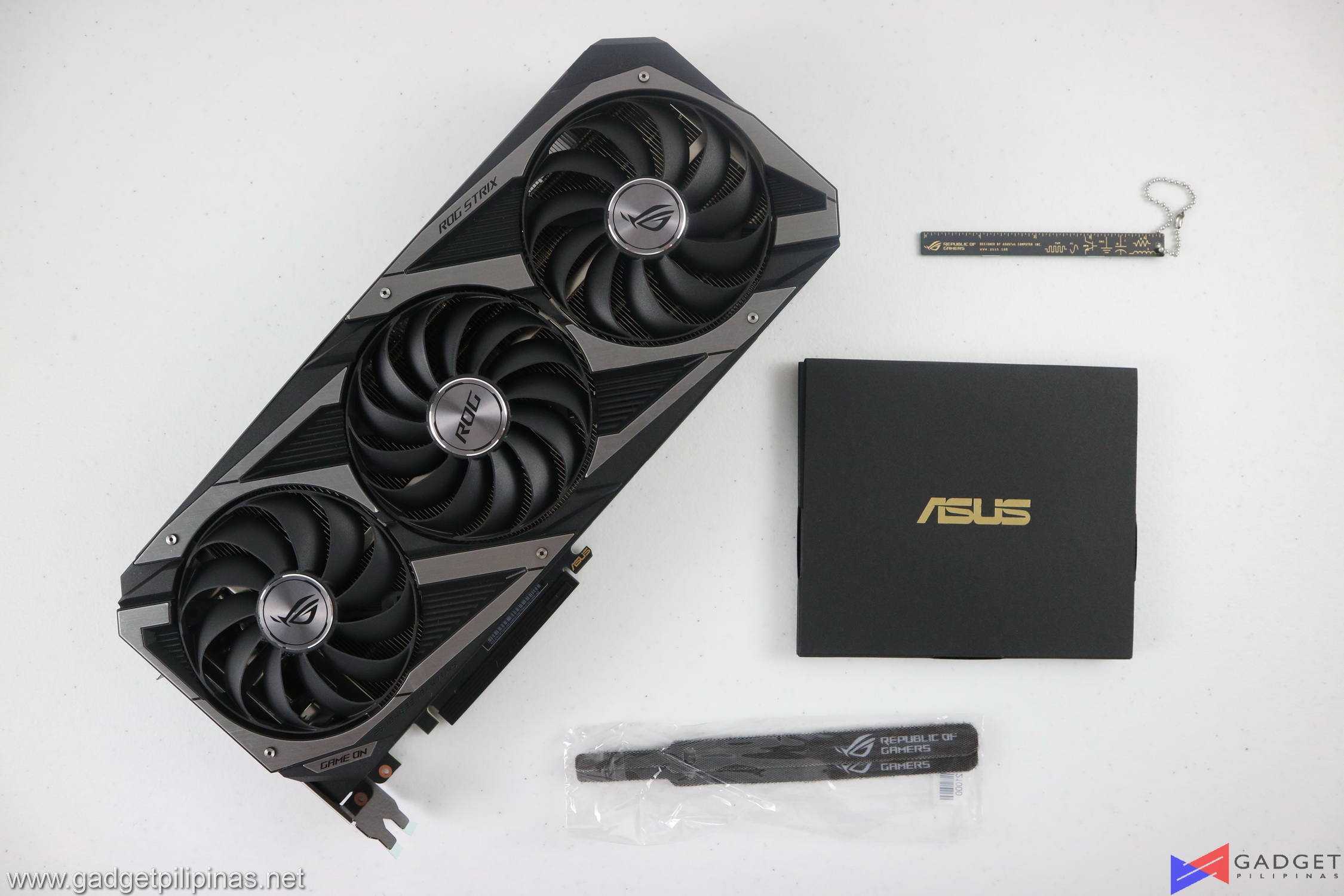 ASUS is pretty generous as far as “freebies” go in a GPU package as the ASUS ROG Strix RTX 3070 comes with two velcro straps and an ROG ruler keychain aside from the standard user manual and warranty card.
ASUS is pretty generous as far as “freebies” go in a GPU package as the ASUS ROG Strix RTX 3070 comes with two velcro straps and an ROG ruler keychain aside from the standard user manual and warranty card.
- ASUS ROG Strix RTX 3070 Review 019
- ASUS ROG Strix RTX 3070 Review 019
- ASUS ROG Strix RTX 3070 Review 024
- ASUS ROG Strix RTX 3070 Review 024
The ASUS ROG Strix RTX 3070 uses an improved Axial-tech design optimized for a more oversized heatsink that features more fins and surface area than the previous generation ROG Strix coolers. ASUS also increased the blade count on all three fans, with the center fan having 13 blades while the auxiliary fans have 11 each. A backplate has been installed in the ROG Strix RTX 3070, acting as a heatsink for better thermals.
Despite the extensive footprint, ASUS has done an excellent job keeping the overall design clean with rounded edges and a simple two-tone finish with no flashy ROG cybertext printing and edgy designs, as seen in the previous RTX 20 series.
ASUS has gone the extra mile to provide an extra HDMI 2.0 port apart from the standard three Display Port 1.4a and one HDMI 2.0 port configuration. The addition of another HDMI port gives the user the flexibility in choosing their own monitor, especially for multi-monitor setups.
The full backplate that extends even to the end of the PCB has a cut out on the right side to allow for air to exhaust, which sort-of follows Nvidia’s flow-through cooler concept, which was introduced alongside the Nvidia RTX 30 series founders edition graphics cards.
- ASUS ROG Strix RTX 3070 Review 031
- ASUS ROG Strix RTX 3070 Review 031
- ASUS ROG Strix RTX 3070 Review 023
- ASUS ROG Strix RTX 3070 Review 023
ASUS is one of the few brands to still include a physical BIOS/Profile switch in their graphics card, albeit only available to ROG Strix and ASUS TUF Models. We used the default profile for testing purposes, which is performance mode, as most users will run the graphics card at its out-of-the-box settings.
The Nvidia RTX 3070 has a TGP rating of 220W and therefore only requires one 8-pin PCI-E connector to provide the said power. Being an OC model, the ROG Strix RTX 3070 OC requires two 8-pin PCI-E connectors. ASUS recommends a 750W power supply for the ROG Strix RTX 3070 OC.
The ROG Strix design is definitely one of the largest cooling shrouds for the RTX 30 series occupying 2.9 slots compared to the average 2.25 to 2.5slots for a graphics card. The ROG Strix 3070 is also one of the longest graphics cards measuring at 318.5mm x 140.1mm x 57.8mm.
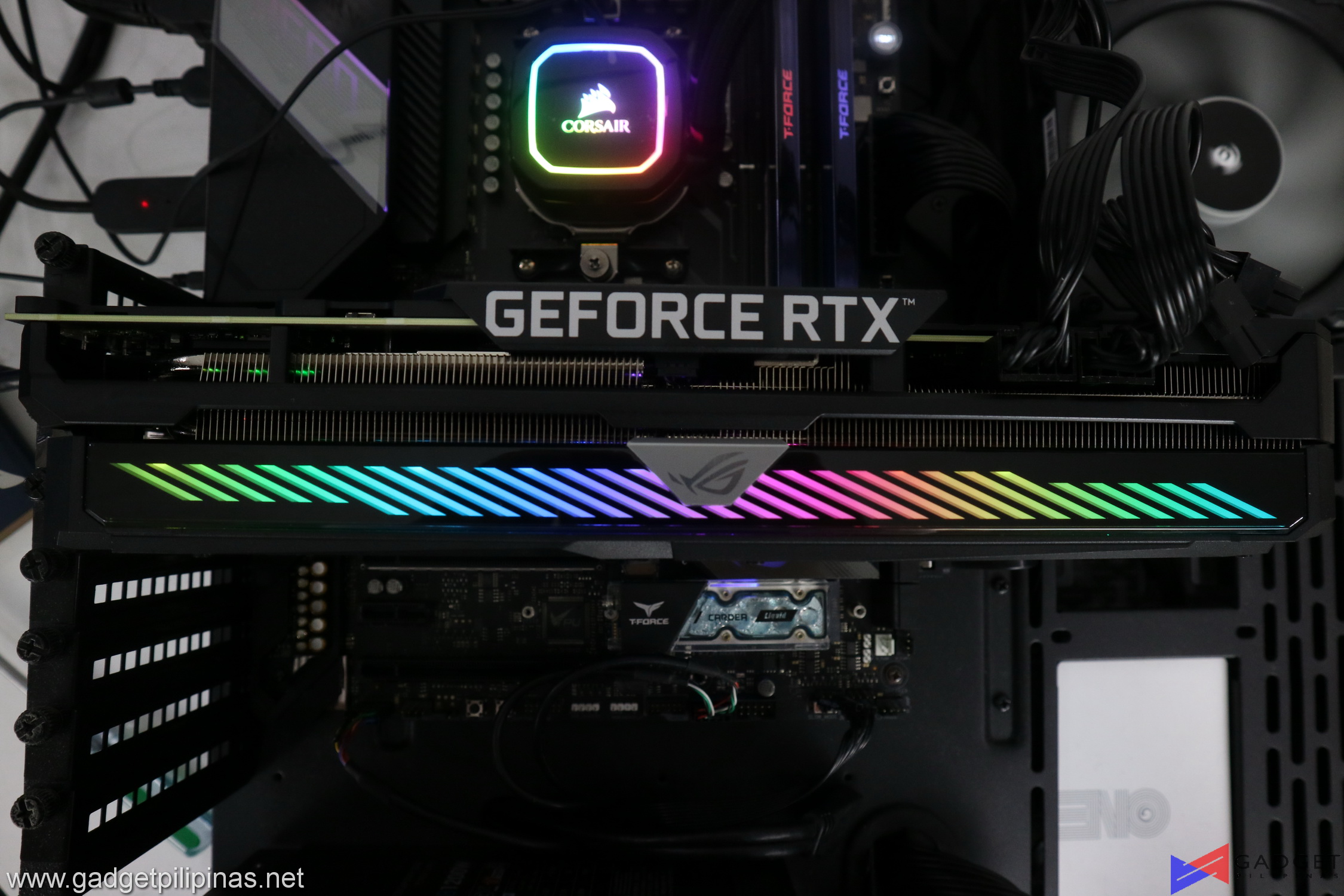 Compared to the last generation’s design, ASUS went for a more aggressive yet clean RGB lighting with the latest ROG Strix graphics card. Like any other ASUS product, the ROG Strix RTX 3070’s RGB lighting supports ASUS AuraSync and can be synced with any AuraSync supported device via the ROG Armoury crate software.
Compared to the last generation’s design, ASUS went for a more aggressive yet clean RGB lighting with the latest ROG Strix graphics card. Like any other ASUS product, the ROG Strix RTX 3070’s RGB lighting supports ASUS AuraSync and can be synced with any AuraSync supported device via the ROG Armoury crate software.
TestBench Setup and Benchmark Methodology
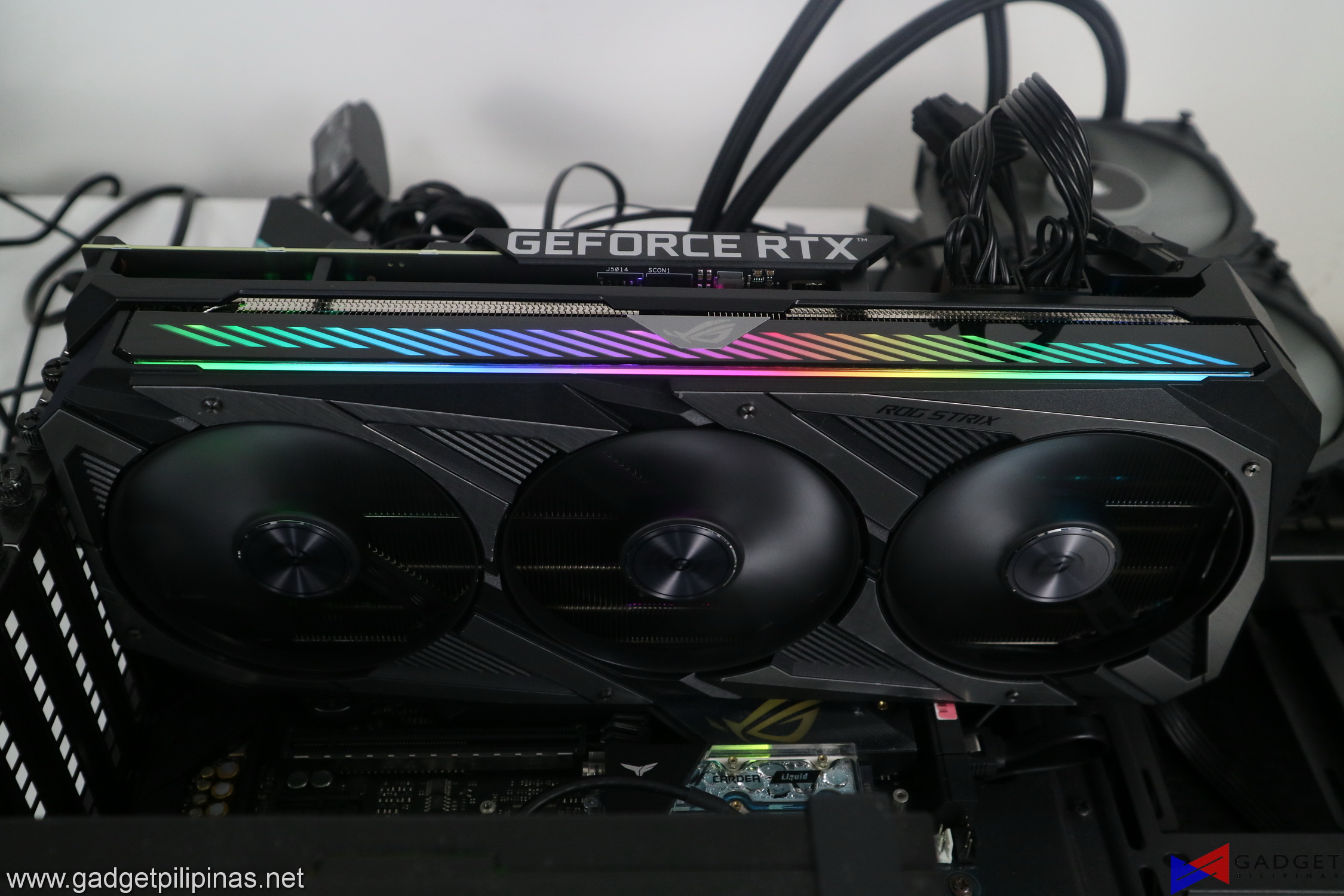 Gadget Pilipinas’ testing philosophy is to provide detail-oriented results as accurately as possible that our readers can replicate our tests given that these conditions are met. Different benchmarking apps and sequences are used depending on the component or device being tested.
Gadget Pilipinas’ testing philosophy is to provide detail-oriented results as accurately as possible that our readers can replicate our tests given that these conditions are met. Different benchmarking apps and sequences are used depending on the component or device being tested.
| ASUS ROG Strix RTX 3070 OC Review Test Bench Specs | ||||
| CPU | AMD Ryzen 9 5950X | |||
| COOLER | Corsair H100i RGB PRO XT 240mm AIO – Noctua NT-H2 Thermal Paste | |||
| MOTHERBOARD | ASUS ROG Crosshair VIII Hero (Wi-Fi) | |||
| MEMORY | Tforce XTREEM ARGB 16GB(2x8GB) 3600Mhz DDR4 | |||
| GPU | ROG Strix RTX 3070 OC | Nvidia RTX 3070 Founders Edition | Inno3D iChill RTX 3070 | Palit RTX 3070 Gaming Pro | ||
| STORAGE | WD SN750 1TB NVMe SSD | |||
| POWERSUPPLY | ThermalTake ToughPower 1200w Platinum | |||
| OPERATING SYSTEM | Windows 10 Pro Build 19041 | |||
| DISPLAY | Lenovo Legion Y27Q Gaming Monitor | |||
We use CapFrameX 1.5.7 Beta as our FPS capture and analysis tool for all our gaming benchmarks. The latest build version of Windows 10 and WHQL certified drivers are used for our benchmarks. Readings such as temperatures and power draw are recorded using HWMonitor and HWInfo64, as well as other relevant software are used for cross-checking.
Our benchmark list and methodology may change in the future depending on the industry trend.
Benchmark list
- Geekbench 5
- V-Ray
- 3DMark
- DOTA 2
- Rainbow Six Siege
- Metro Exodus
- Far Cry 5
- Shadow of the Tomb Raider
- F1 2020
- Cyberpunk 2077
- Assassins Creed: Odyssey
- Horizon Zero Dawn
- Godfall
ASUS ROG Strix RTX 3070 Synthetic Benchmarks
3DMARK
- ASUS ROG Strix RTX 3070 Review 3DMark Firestrike
- ASUS ROG Strix RTX 3070 Review 3DMark Firestrike
- ASUS ROG Strix RTX 3070 Review 3DMark Port Royal
- ASUS ROG Strix RTX 3070 Review 3DMark Port Royal
- ASUS ROG Strix RTX 3070 Review 3DMark TimeSpy
- ASUS ROG Strix RTX 3070 Review 3DMark TimeSpy
3DMark is the go-to benchmark for gamers because of the ability to share and compare results online.
GeekBench 5
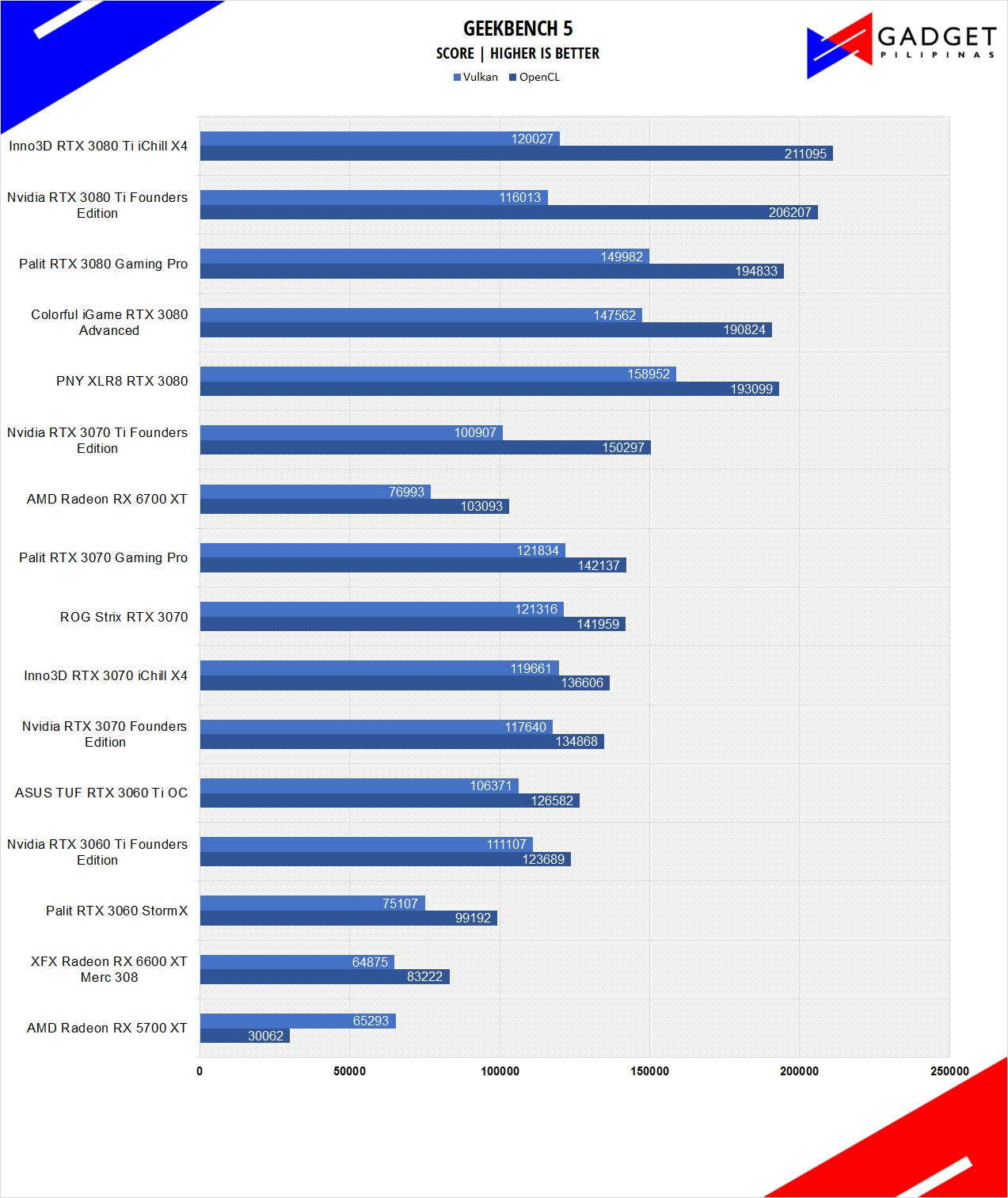 Geekbench is a multi-platform benchmark that’s used to gauge CPU performance and compare them across Windows, Mac, and Mobile. Geekbench 5 is the latest version It doesn’t rely on memory as much as the previous Geekbench 4, making it a great tool to measure both single-core and multi-core CPU performance. For our GPU reviews, we both measure OpenCL and Vulkan performance.
Geekbench is a multi-platform benchmark that’s used to gauge CPU performance and compare them across Windows, Mac, and Mobile. Geekbench 5 is the latest version It doesn’t rely on memory as much as the previous Geekbench 4, making it a great tool to measure both single-core and multi-core CPU performance. For our GPU reviews, we both measure OpenCL and Vulkan performance.
V-RAY
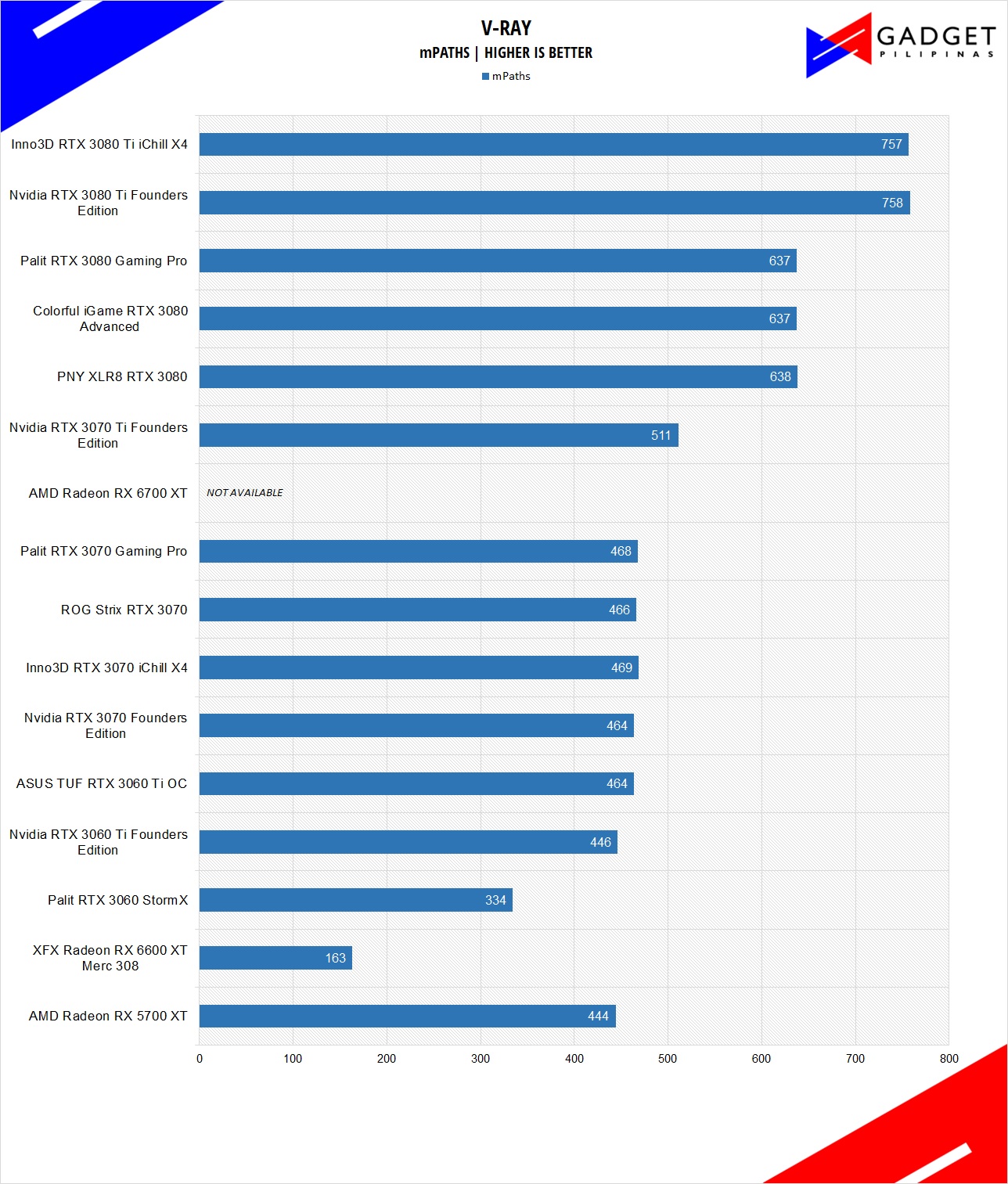 V-Ray Benchmark is a stand-alone version of V-Ray developed by Chaos Group. It is designed to test the CPU and GPU by rendering sample scenes at a fixed amount of time. V-Ray is a plug-in primarily utilized by 3D computer graphics software applications mainly for industrial design, product design, architecture, film, and video game production. V-Ray is not limited to 64-threads as it supports multi and mega-threading.
V-Ray Benchmark is a stand-alone version of V-Ray developed by Chaos Group. It is designed to test the CPU and GPU by rendering sample scenes at a fixed amount of time. V-Ray is a plug-in primarily utilized by 3D computer graphics software applications mainly for industrial design, product design, architecture, film, and video game production. V-Ray is not limited to 64-threads as it supports multi and mega-threading.
ASUS ROG Strix RTX 3070 Gaming Benchmarks
DOTA 2
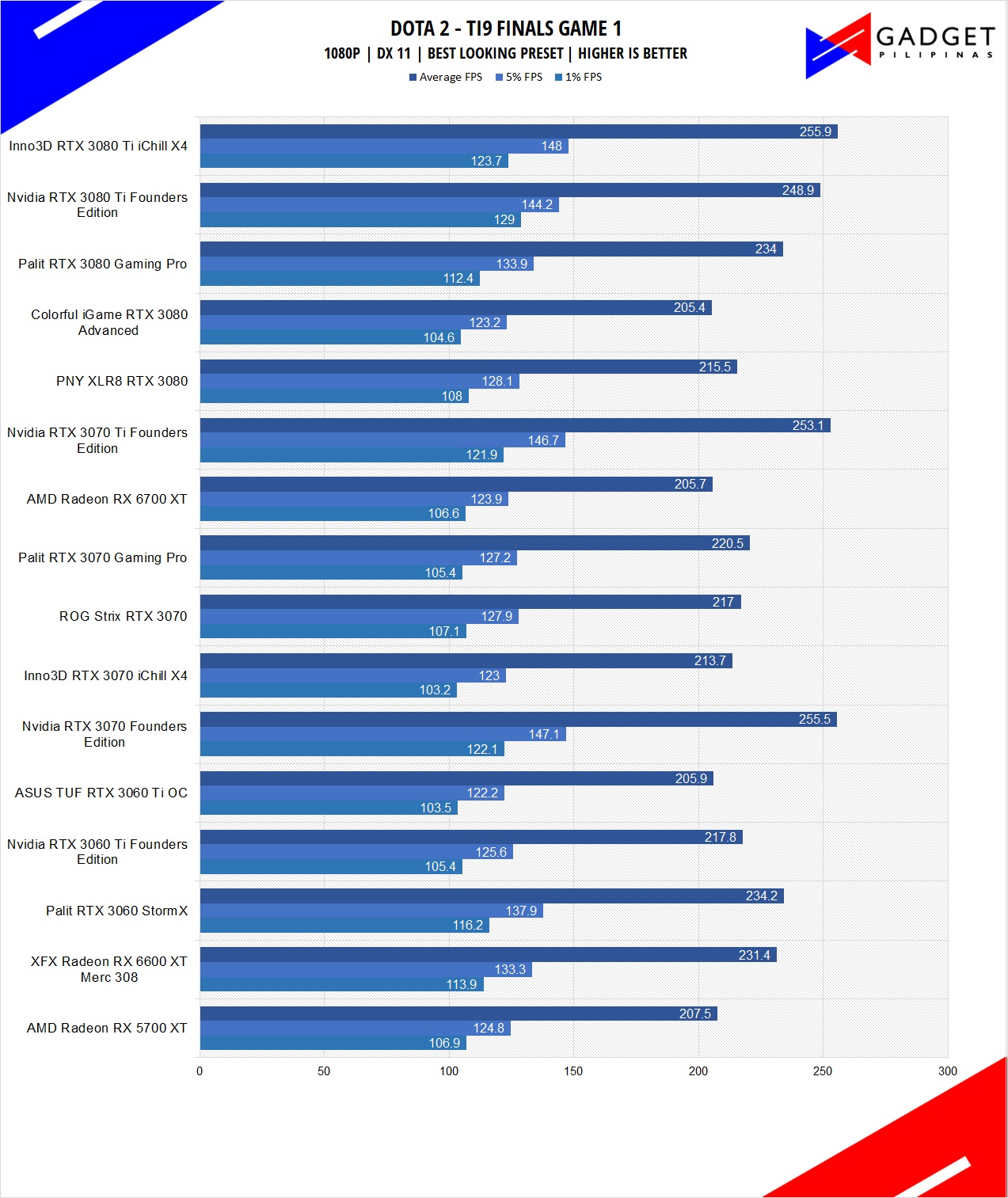
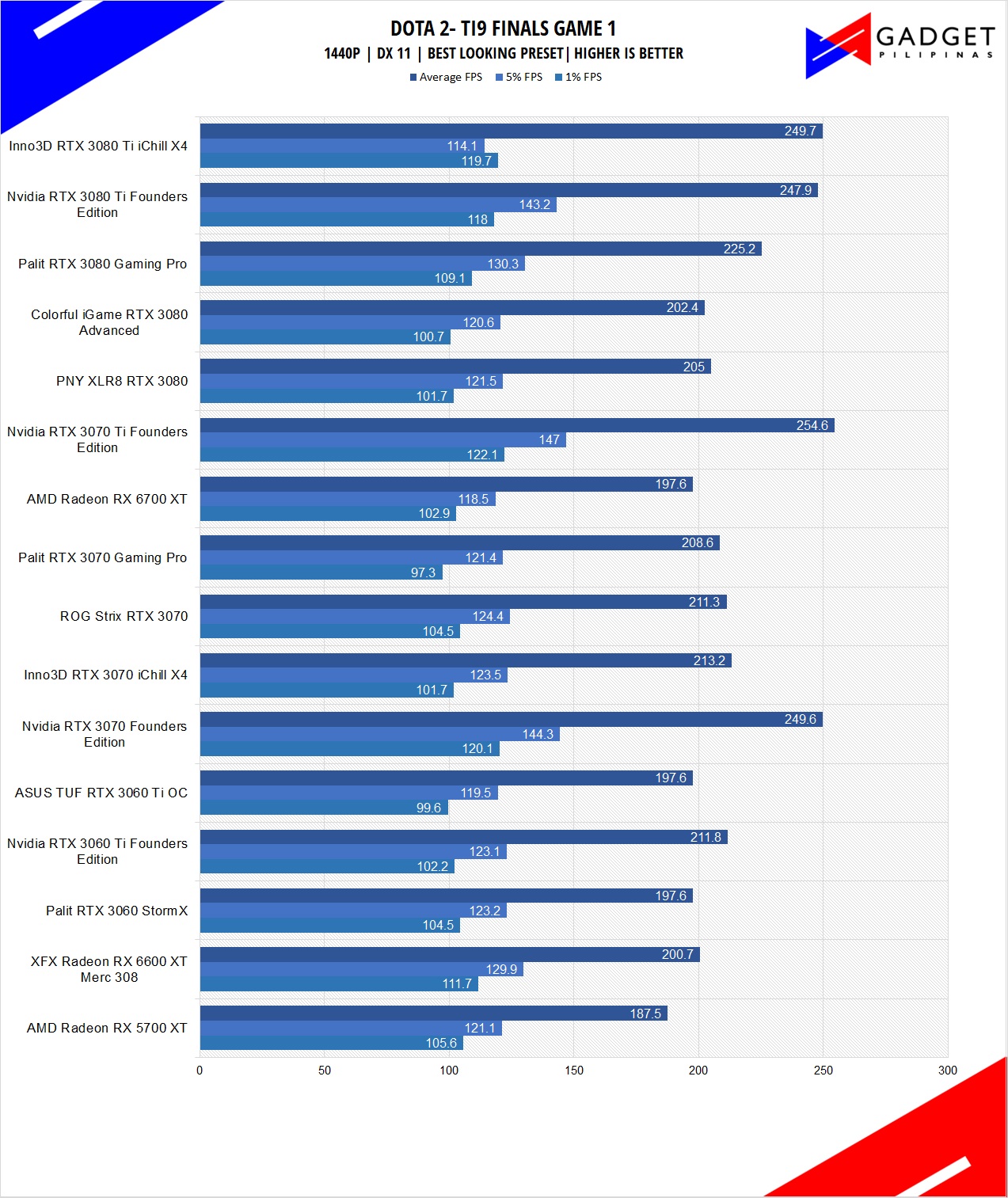
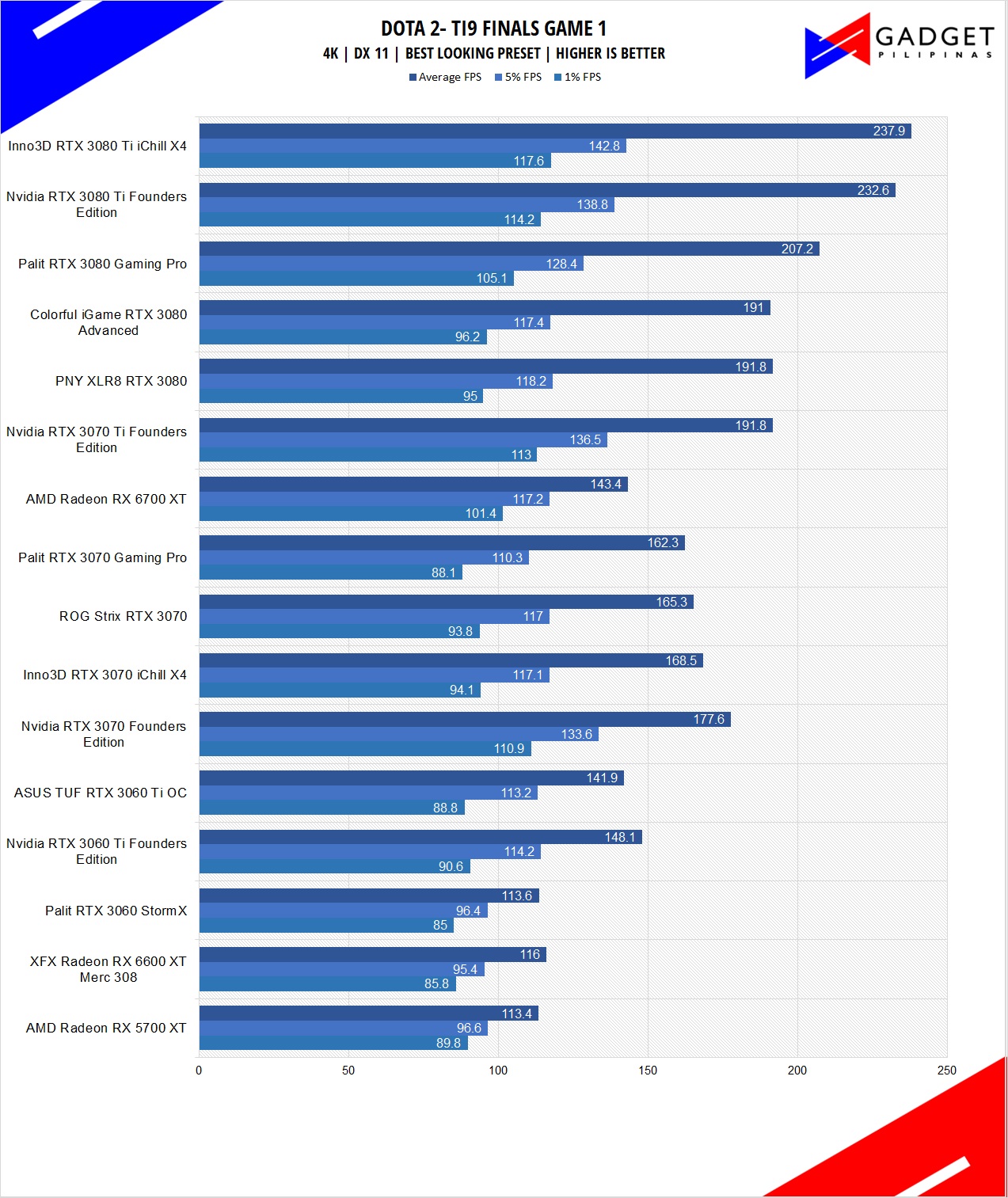 Most gamers play at least one of the following free-to-play titles: League of Legends, CS: GO, Dota 2, and/or Fortnite. Dota 2 is a good representation of the F2P titles as it is the most demanding game in the spectrum. The benchmark will give you an idea of the graphic card’s relative performance on other lesser demanding titles. Our benchmark sequence is based on a replay of OG vs. Liquid in the TI9 grand finals from the team fight that happened from 28:30 to 29:30.
Most gamers play at least one of the following free-to-play titles: League of Legends, CS: GO, Dota 2, and/or Fortnite. Dota 2 is a good representation of the F2P titles as it is the most demanding game in the spectrum. The benchmark will give you an idea of the graphic card’s relative performance on other lesser demanding titles. Our benchmark sequence is based on a replay of OG vs. Liquid in the TI9 grand finals from the team fight that happened from 28:30 to 29:30.
Far Cry 5
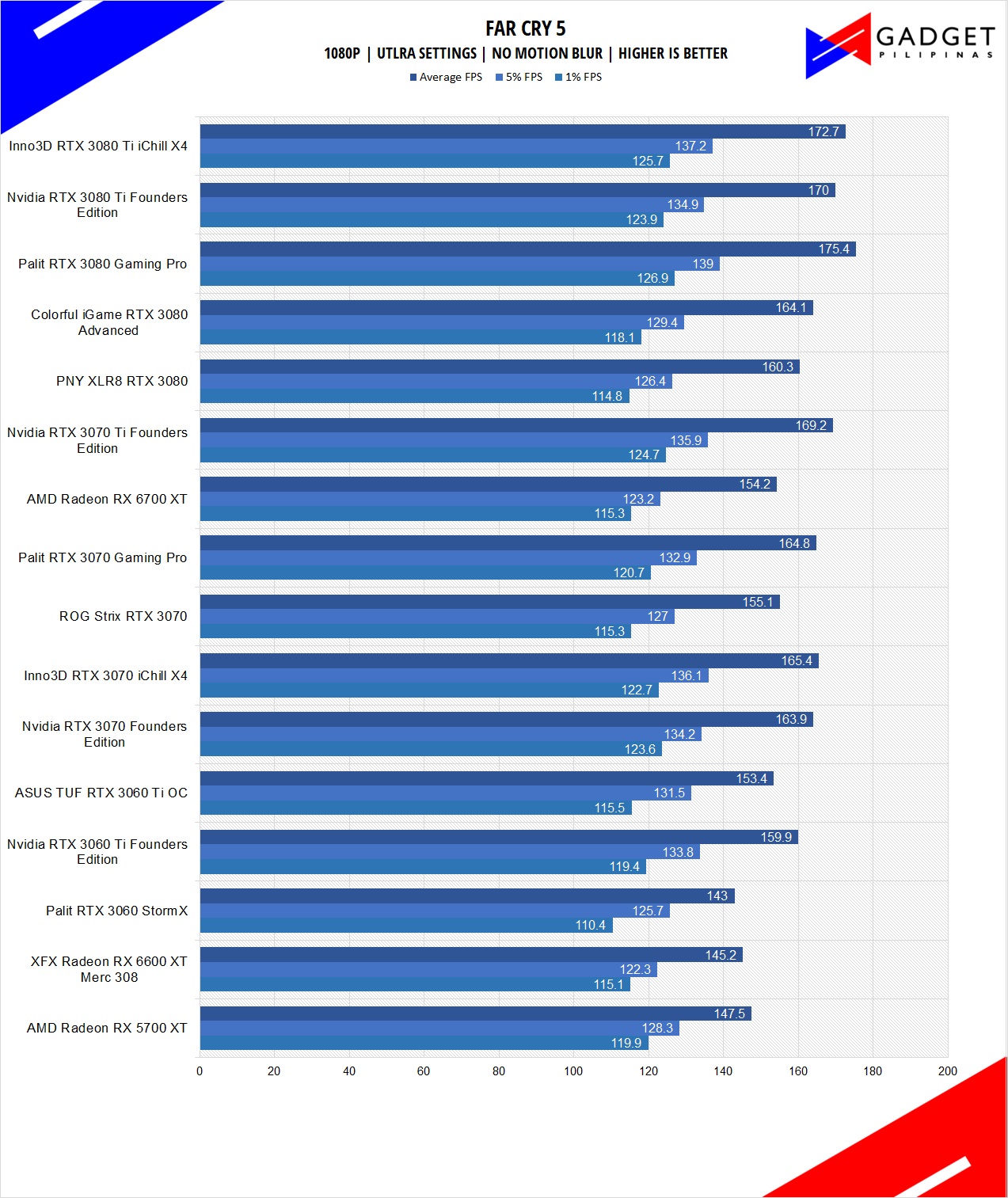
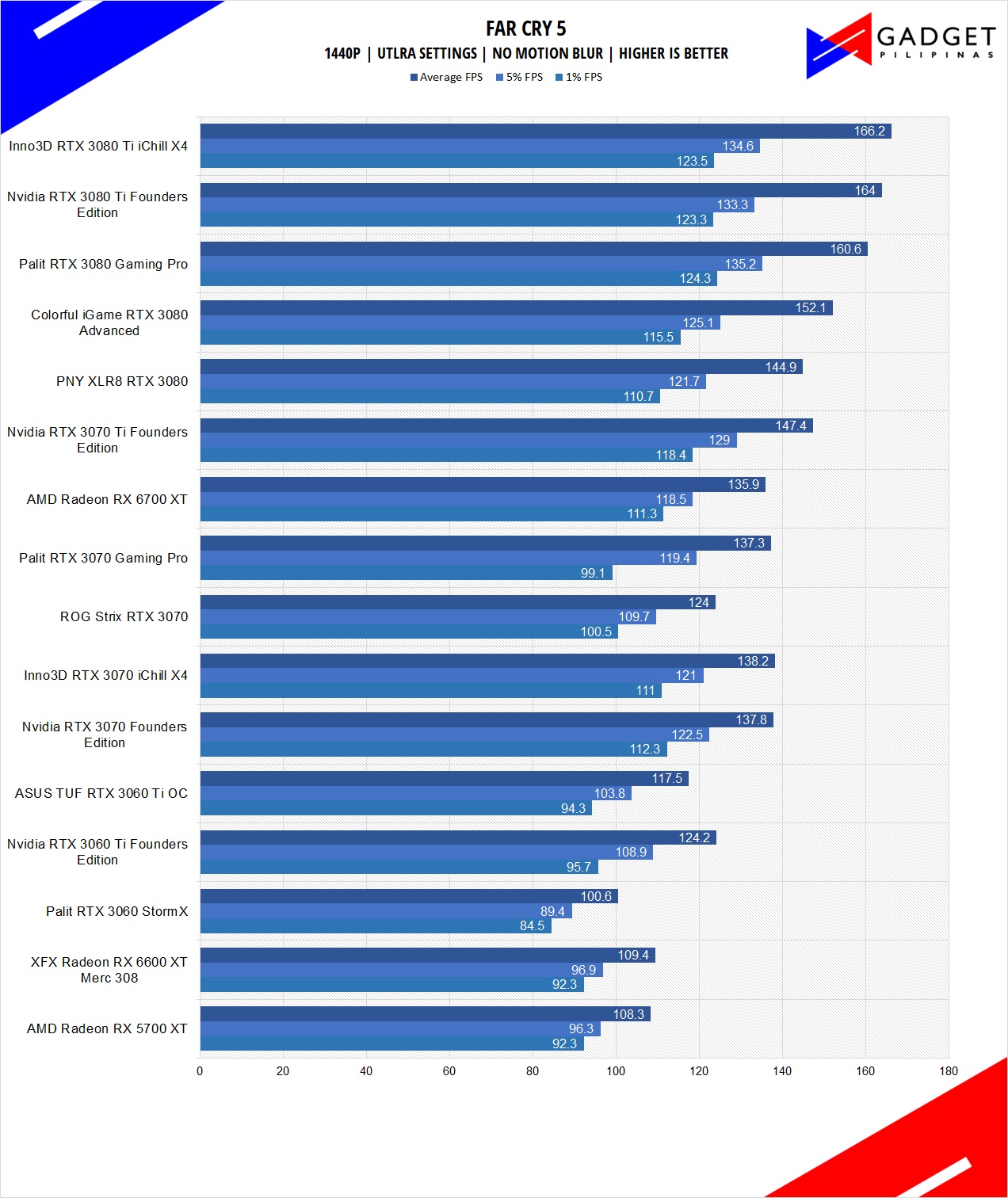
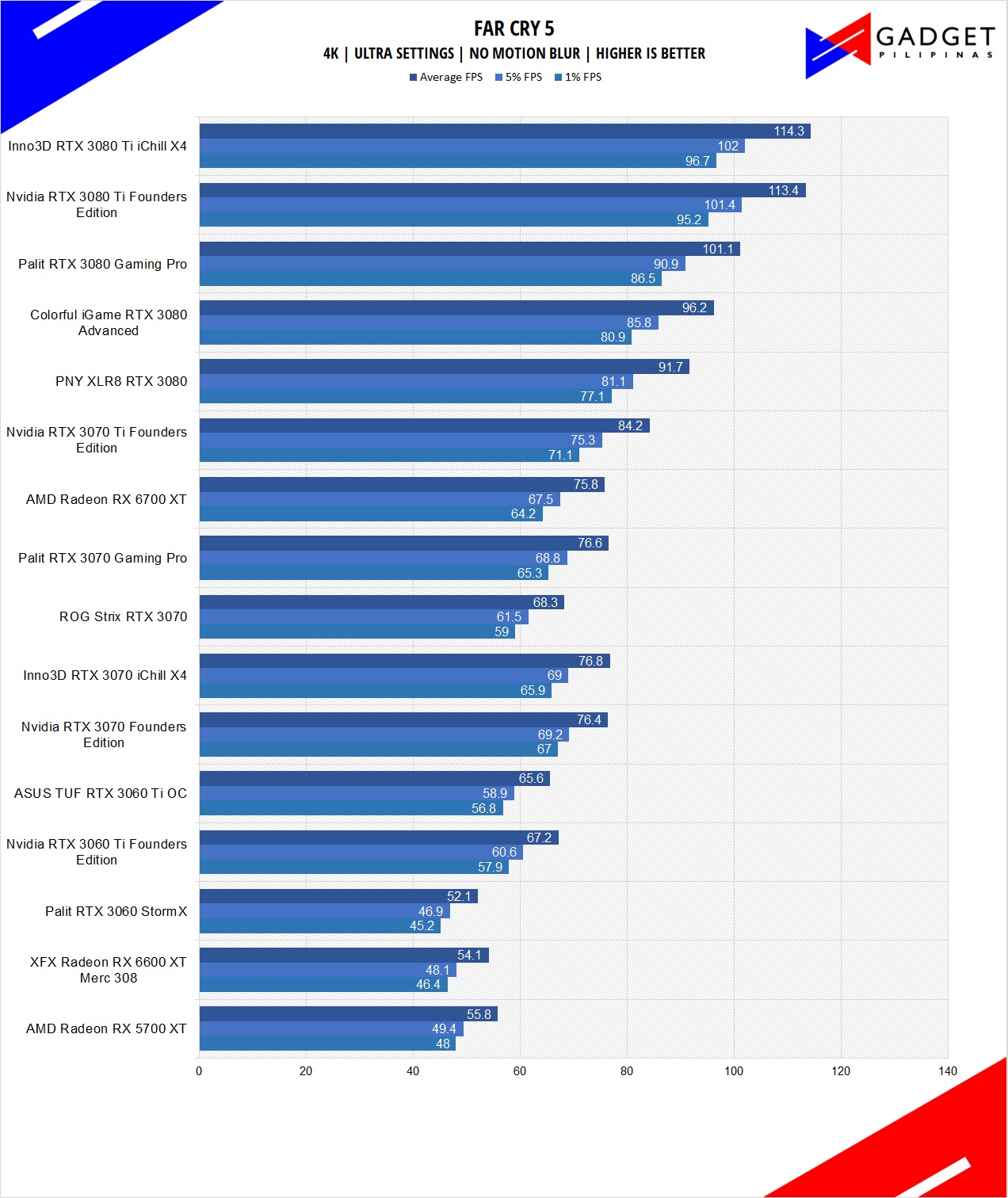 FarCry 5 is an FPS game published by Ubisoft and uses the Dunia engine. It heavily relies on and takes advantage of DirectX 11 to render a realistic environment that makes it taxing to both the CPU and GPU.
FarCry 5 is an FPS game published by Ubisoft and uses the Dunia engine. It heavily relies on and takes advantage of DirectX 11 to render a realistic environment that makes it taxing to both the CPU and GPU.
Rainbow Six Siege
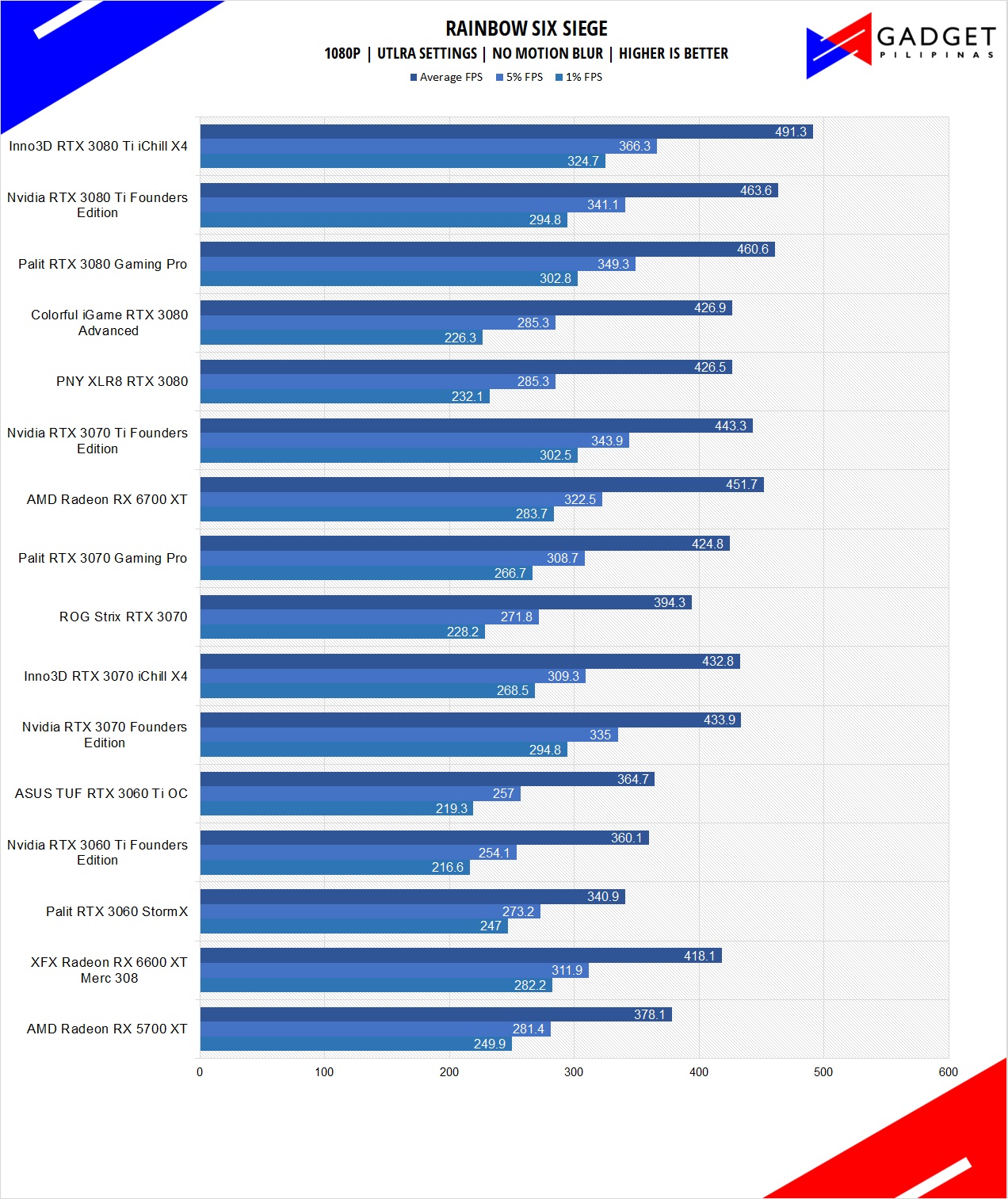
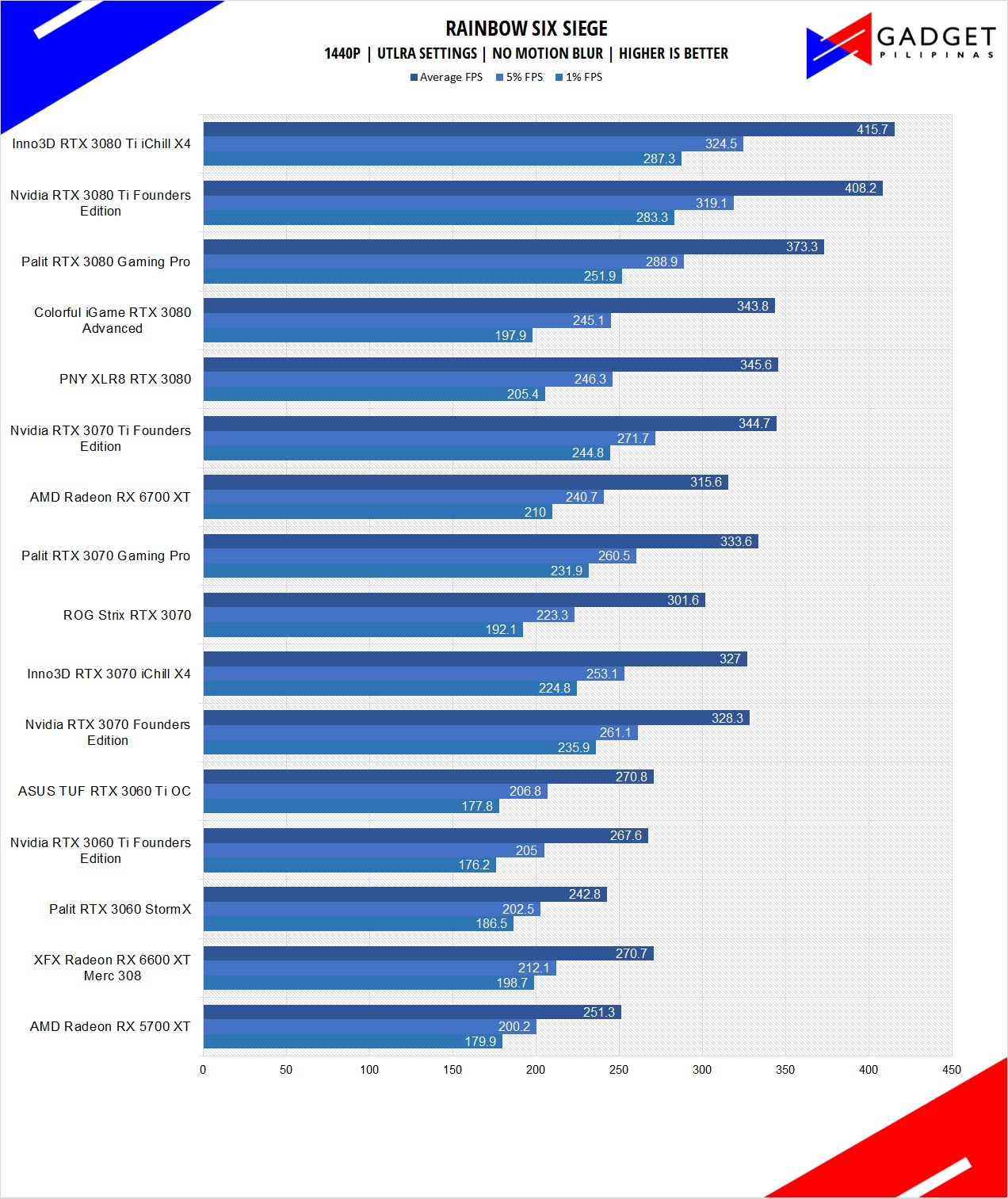
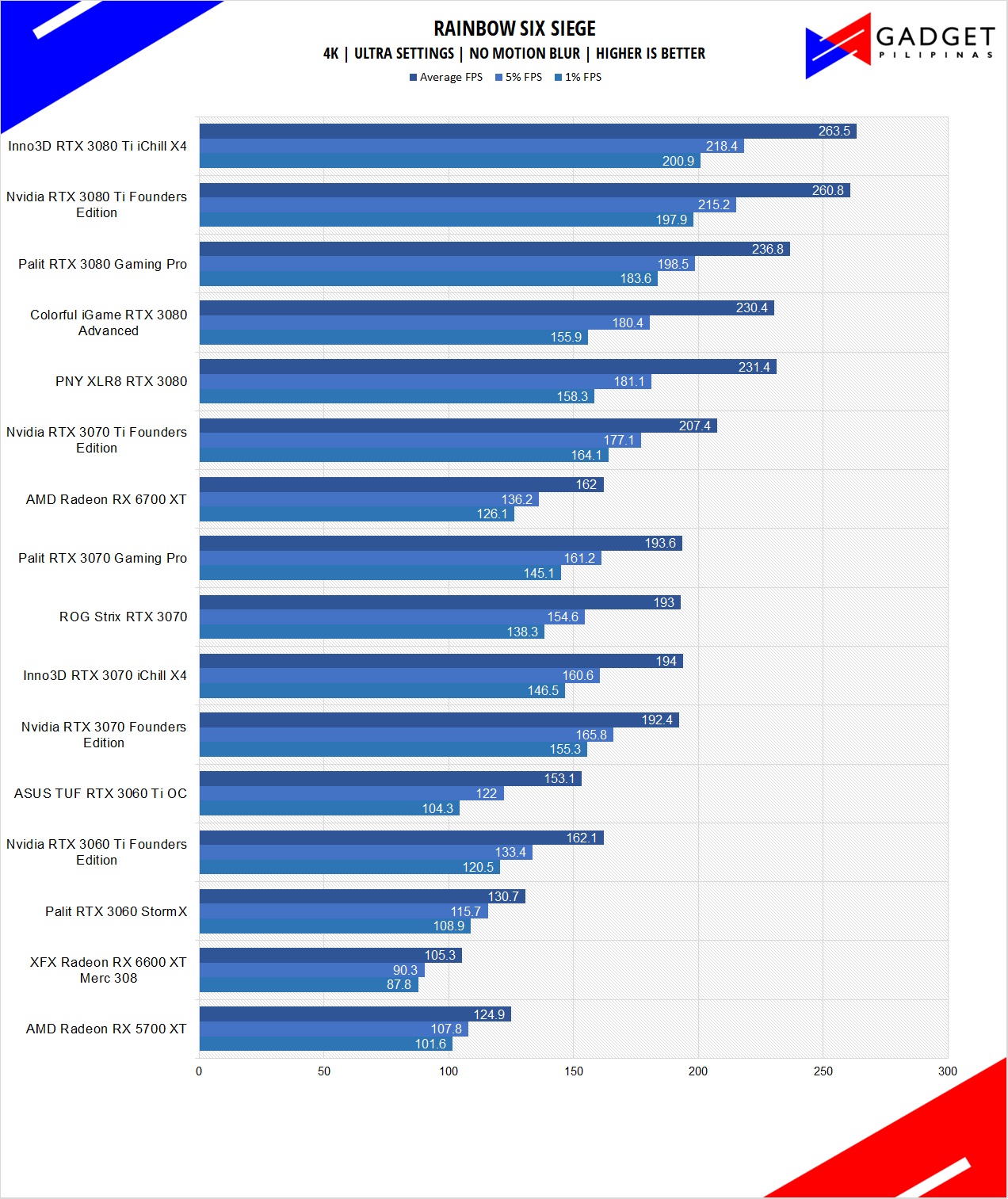 Rainbow Six Seige is one of the few popular AAA games that’s still popular in 2021 due to its competitive gameplay mechanics. R6S uses the AnvilNext game engine, which the game’s publisher, Ubisoft, developed. As of writing, Rainbow Six Siege is currently the most popular Tom Clancy title beating out Wildlands, Breakpoint and even, Division 2. Rainbow Six Seige is one of the few popular AAA games that’s still popular in 2019 due to its competitive gameplay mechanics. R6S uses the AnvilNext game engine, which the game’s publisher, Ubisoft, developed. As of writing, Rainbow Six Siege is currently the most popular Tom Clancy title beating out Wildlands, Breakpoint and even, Division 2.
Rainbow Six Seige is one of the few popular AAA games that’s still popular in 2021 due to its competitive gameplay mechanics. R6S uses the AnvilNext game engine, which the game’s publisher, Ubisoft, developed. As of writing, Rainbow Six Siege is currently the most popular Tom Clancy title beating out Wildlands, Breakpoint and even, Division 2. Rainbow Six Seige is one of the few popular AAA games that’s still popular in 2019 due to its competitive gameplay mechanics. R6S uses the AnvilNext game engine, which the game’s publisher, Ubisoft, developed. As of writing, Rainbow Six Siege is currently the most popular Tom Clancy title beating out Wildlands, Breakpoint and even, Division 2.
Cyberpunk 2077
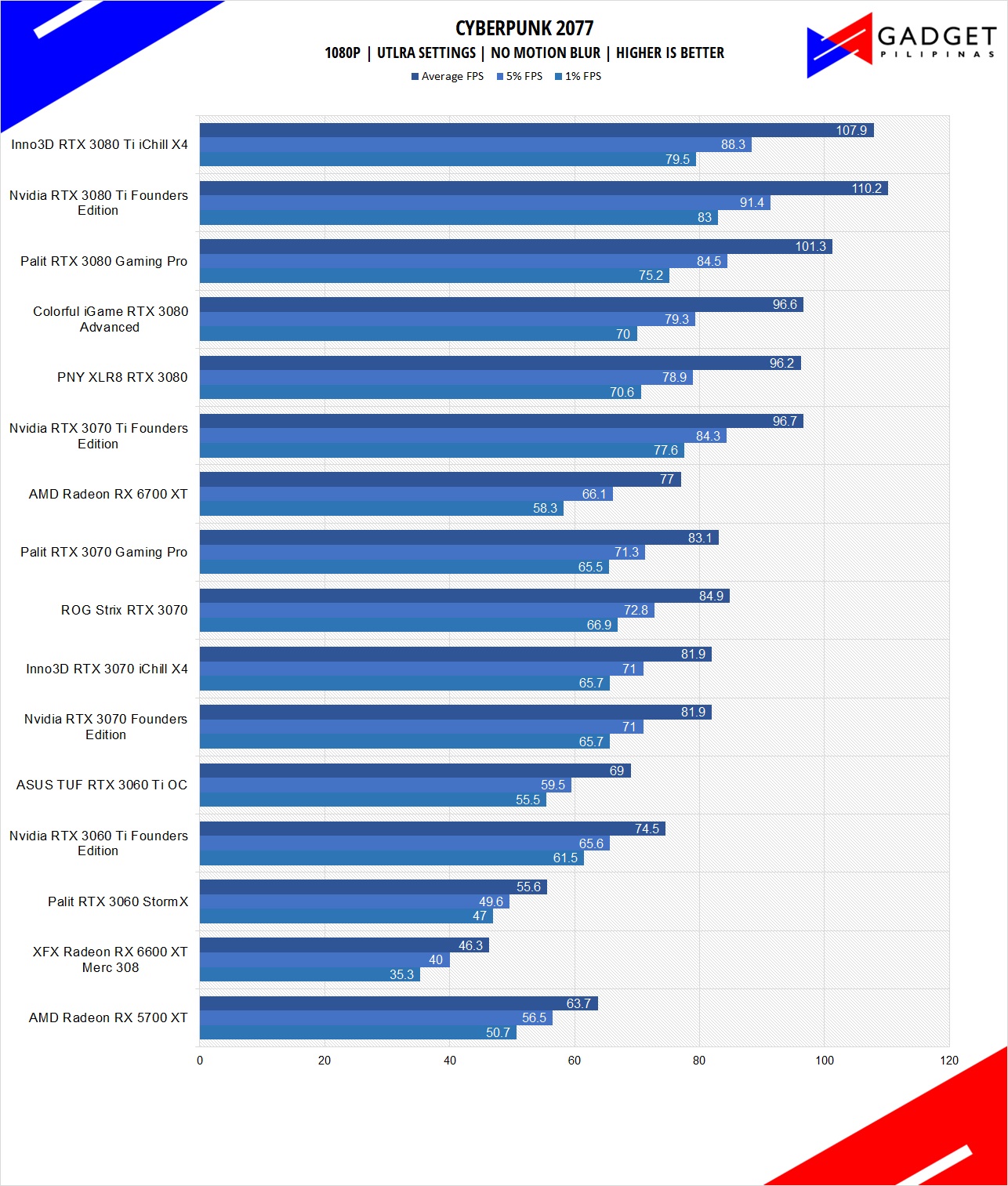
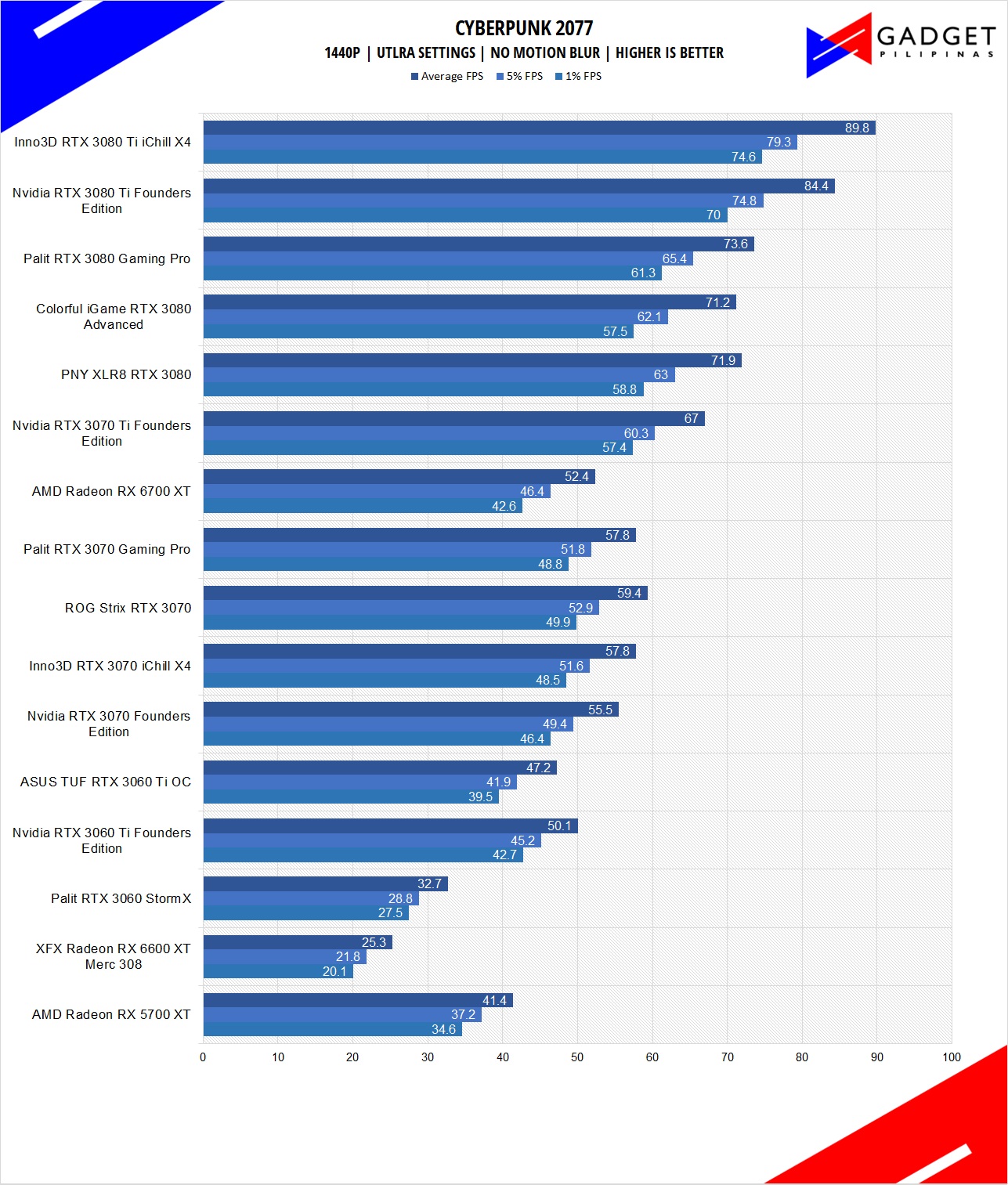
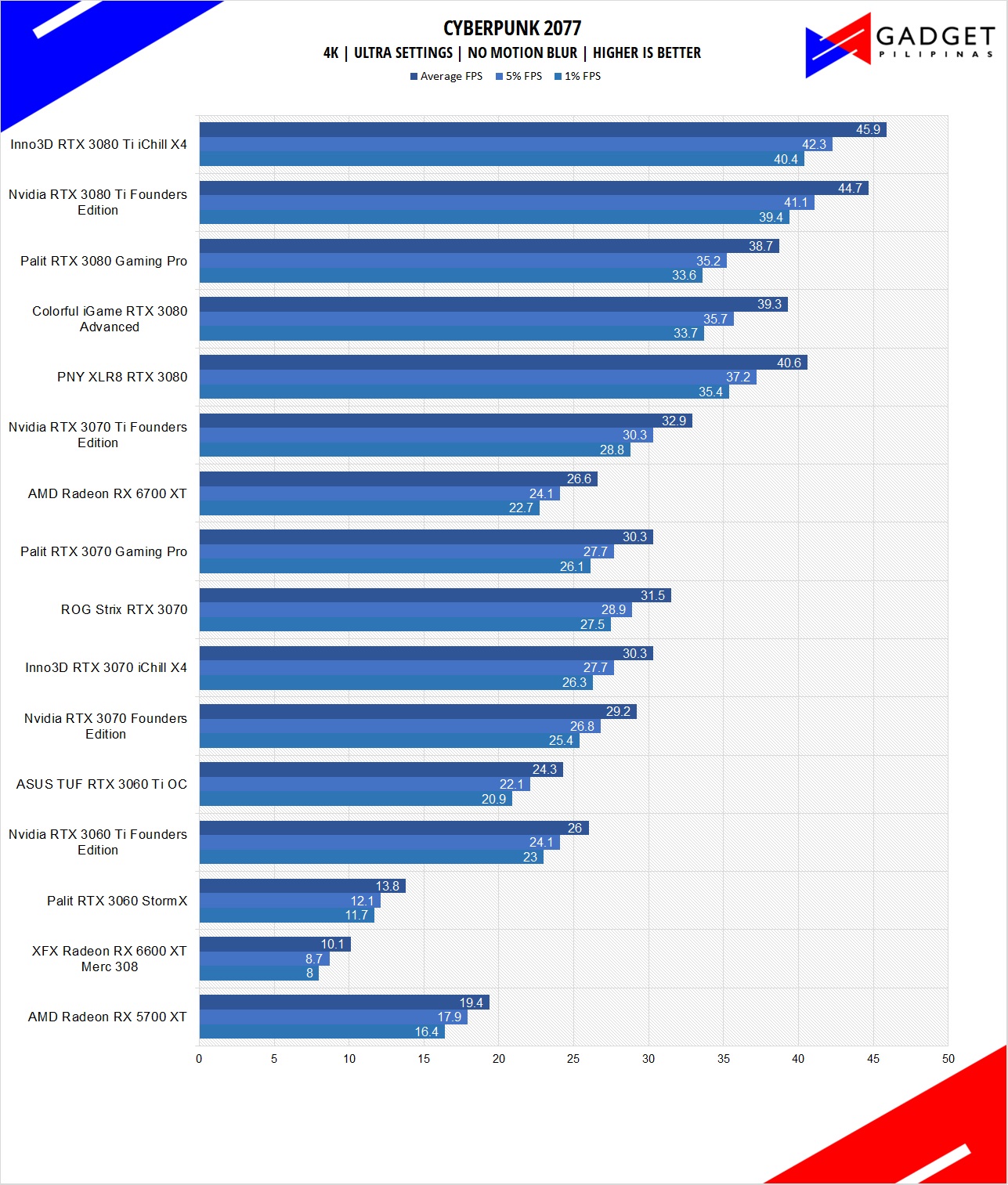 Cyberpunk 2077 is arguably the most hyped game of 2020. Developed by CD Projekt Red, the dystopian open-world, action-adventure RPG sports is one of the most demanding titles to date. Cyberpunk 2077 also supports three Ray Tracing settings as well as DLSS, which makes the game a great tool to measure Ray tracing performance for both AMD and Nvidia graphics cards.
Cyberpunk 2077 is arguably the most hyped game of 2020. Developed by CD Projekt Red, the dystopian open-world, action-adventure RPG sports is one of the most demanding titles to date. Cyberpunk 2077 also supports three Ray Tracing settings as well as DLSS, which makes the game a great tool to measure Ray tracing performance for both AMD and Nvidia graphics cards.
Horizon Zero Dawn
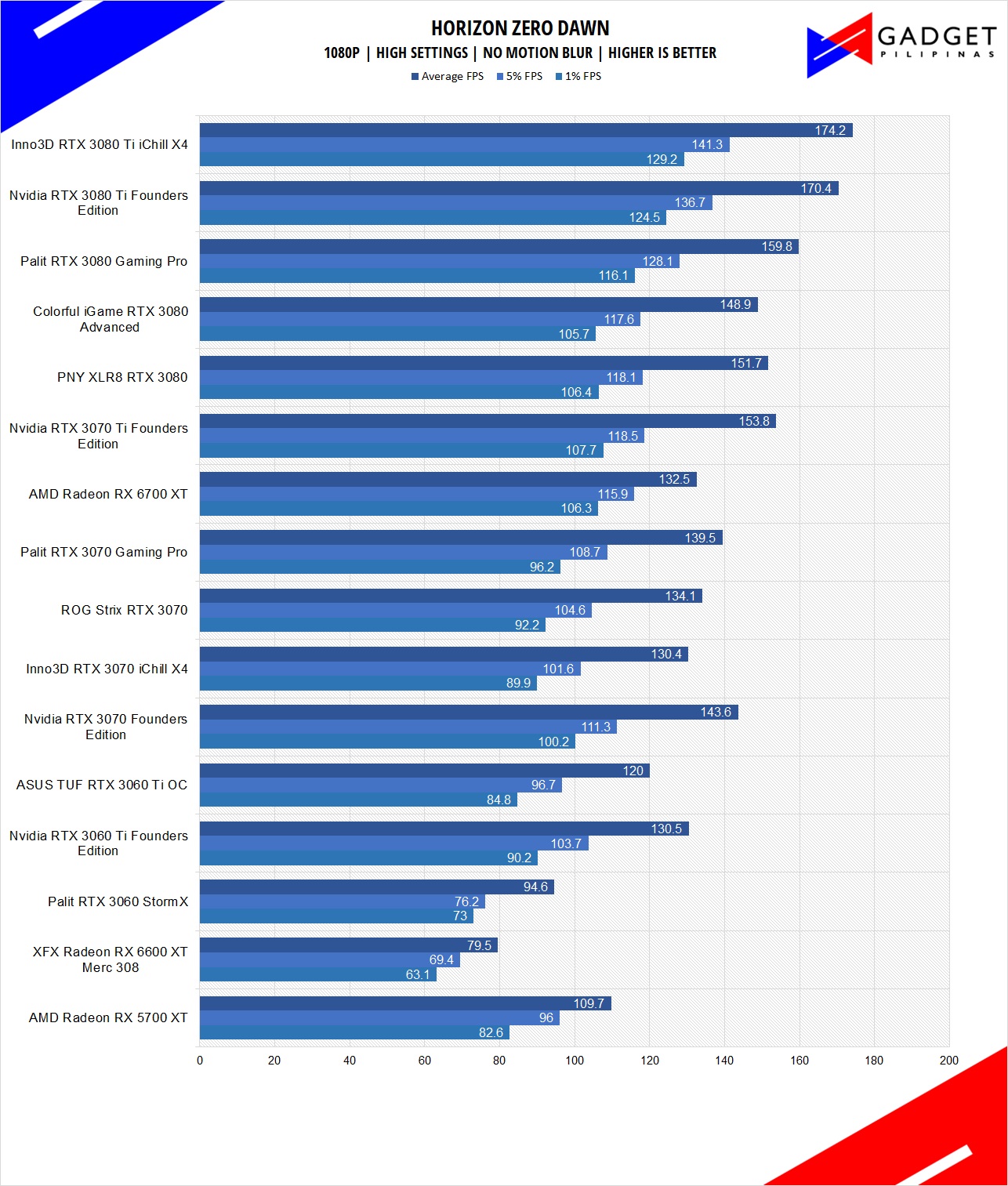
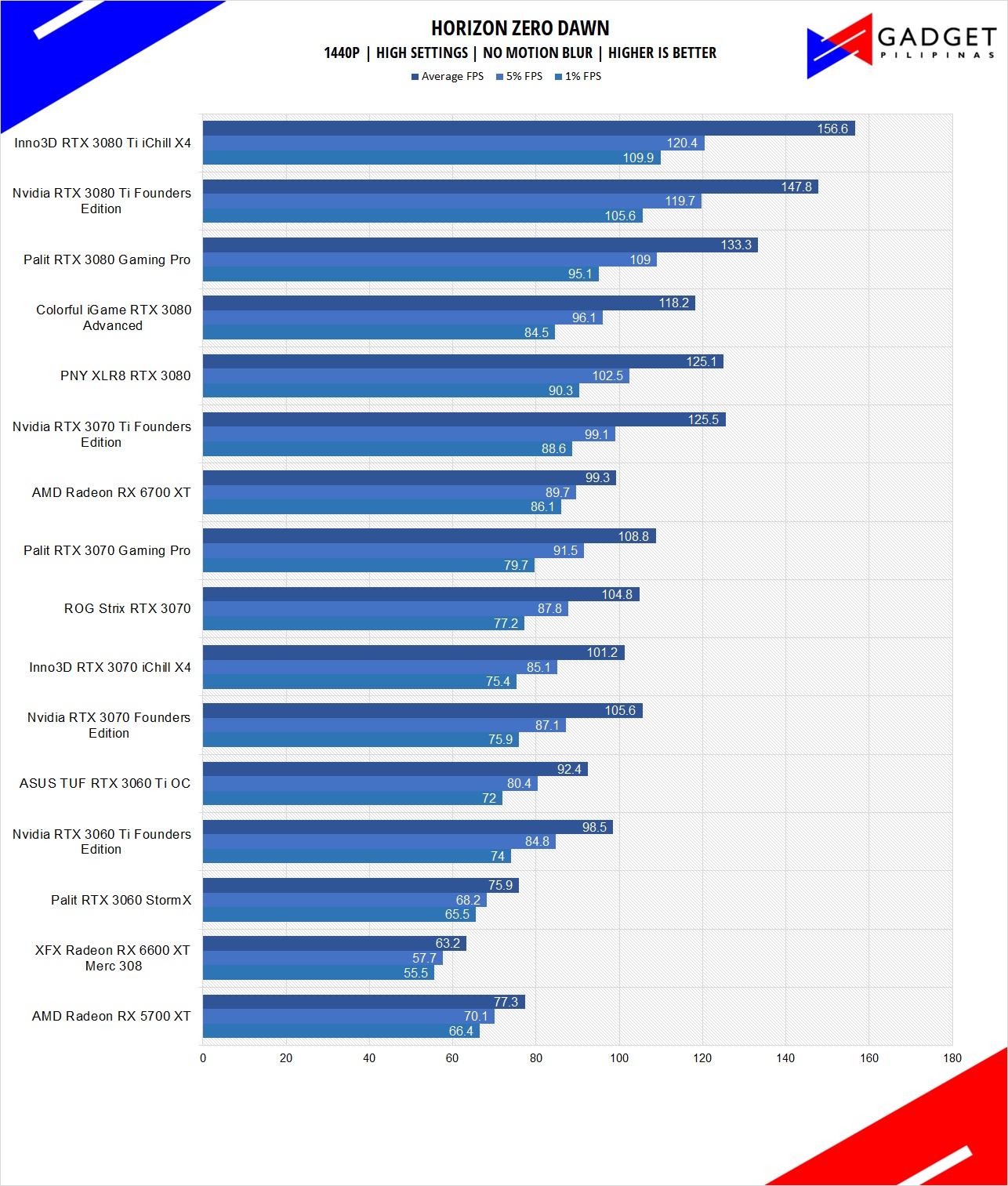
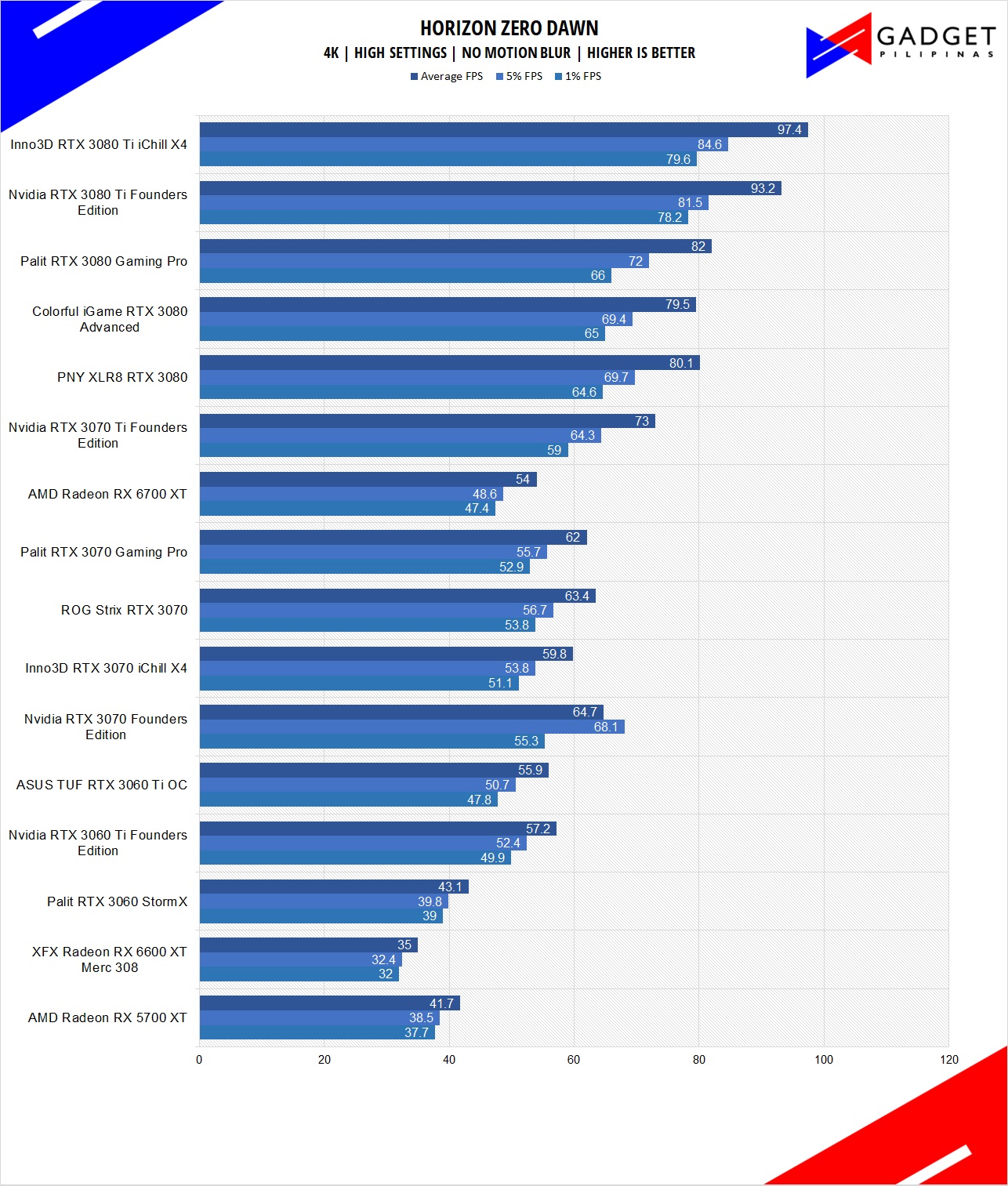 Horizon Zero Dawn is one of the most popular console-port RPG developed by Guerilla Games and published by Sony Interactive Entertainment. Horizon Zero Dawn is a multi-award-winning action RPG, and its popularity resulted in an exclusive Complete Edition game bundle in Steam.
Horizon Zero Dawn is one of the most popular console-port RPG developed by Guerilla Games and published by Sony Interactive Entertainment. Horizon Zero Dawn is a multi-award-winning action RPG, and its popularity resulted in an exclusive Complete Edition game bundle in Steam.
Shadow of The Tomb Raider
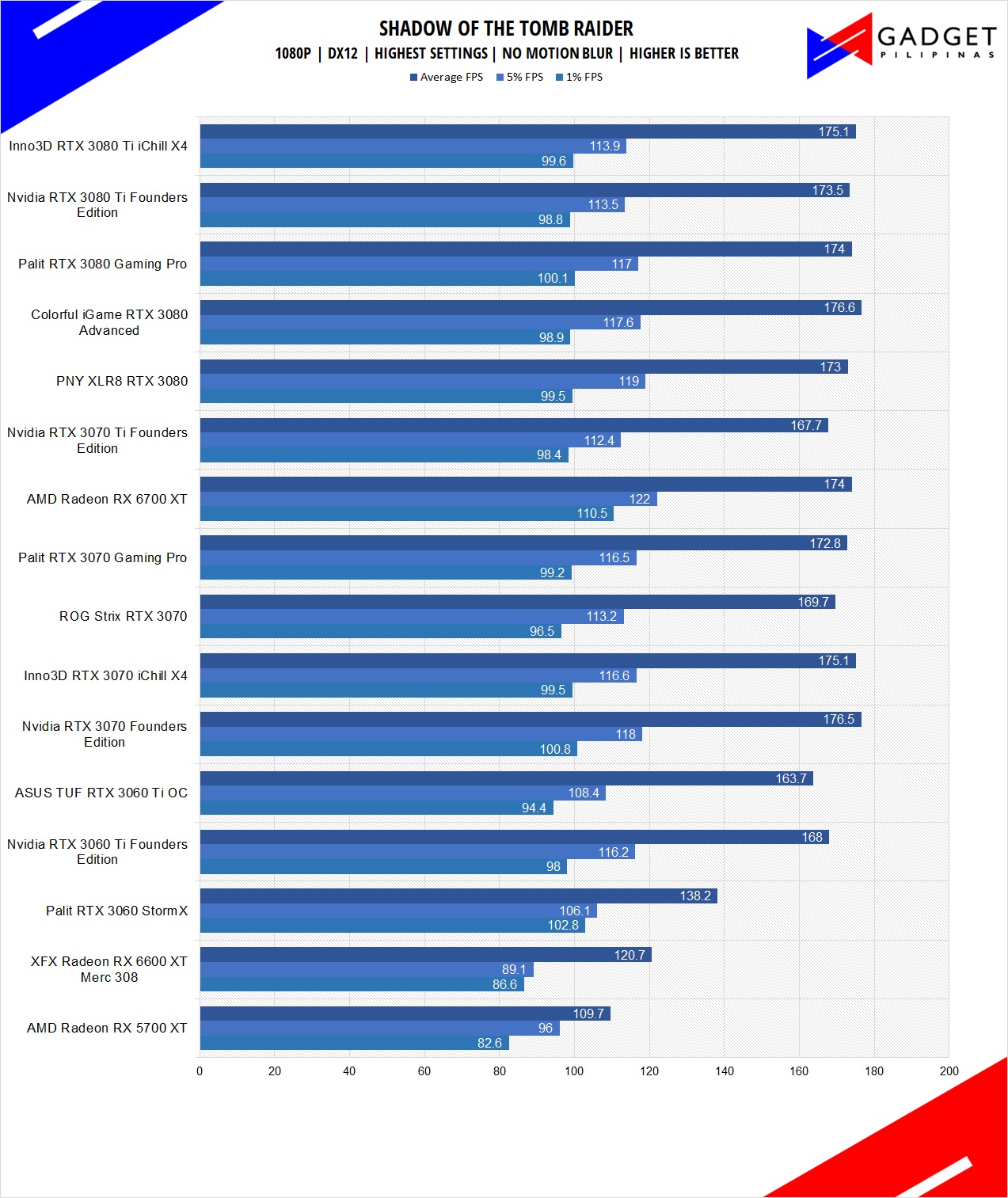
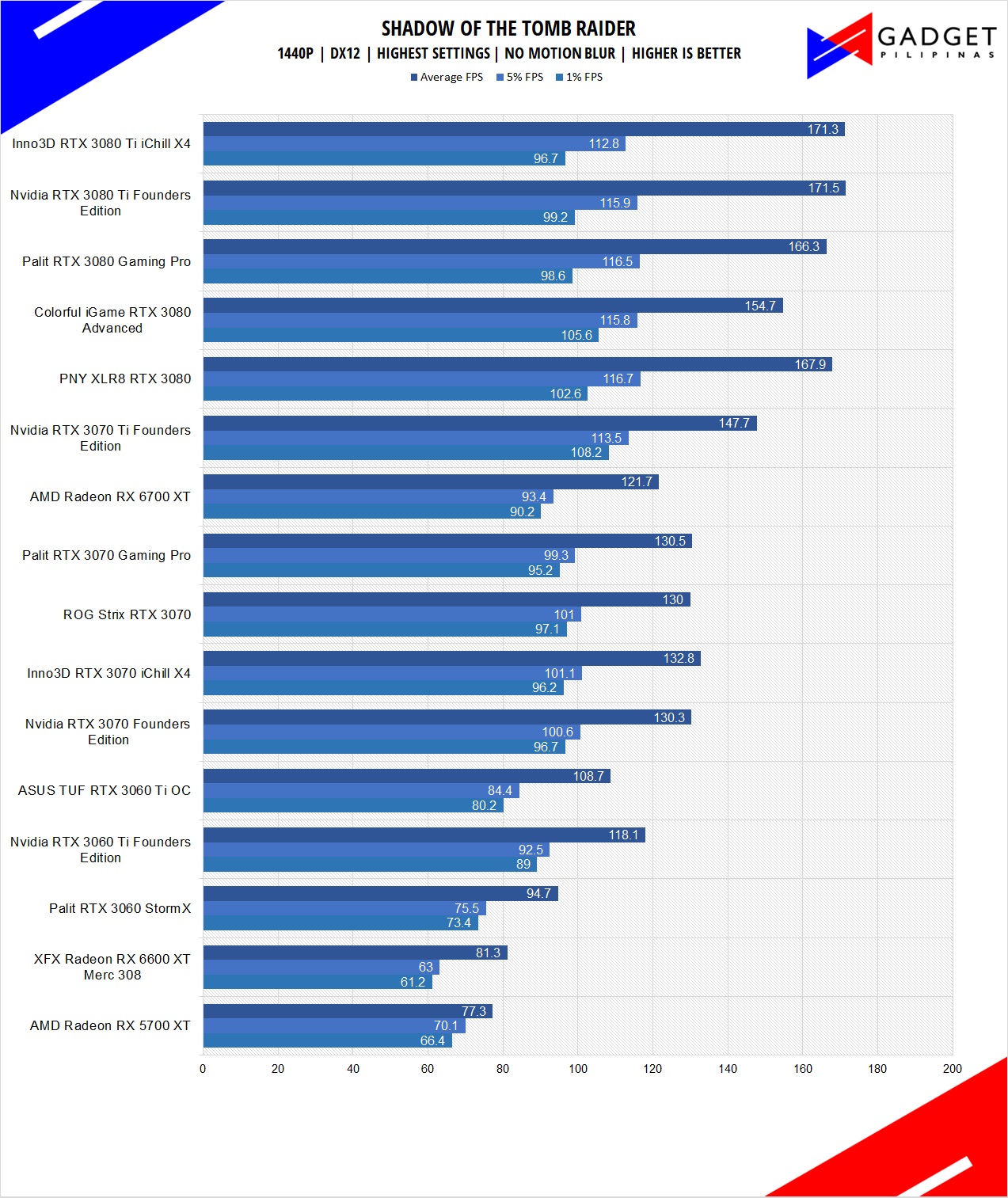
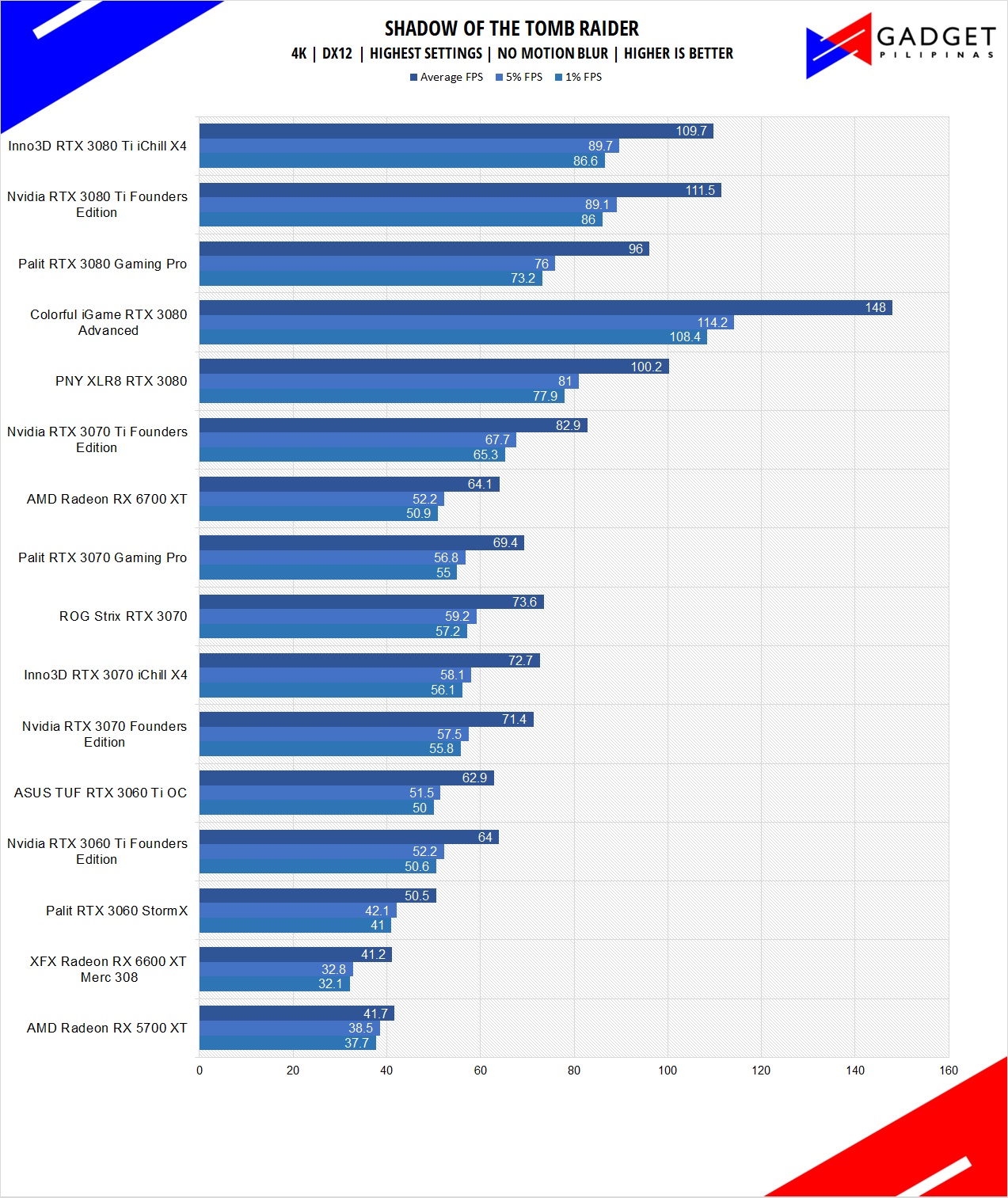 Shadow of The Tomb Raider or SOTR is the latest installment of the Lara Croft Tomb Raider franchise. Developed by Square Enix, SOTR uses the Foundation engine and is further enhanced by Eidos Montreal. STOR is also one of the first games to come out with Ray Tracing and DLSS support.
Shadow of The Tomb Raider or SOTR is the latest installment of the Lara Croft Tomb Raider franchise. Developed by Square Enix, SOTR uses the Foundation engine and is further enhanced by Eidos Montreal. STOR is also one of the first games to come out with Ray Tracing and DLSS support.
Metro Exodus
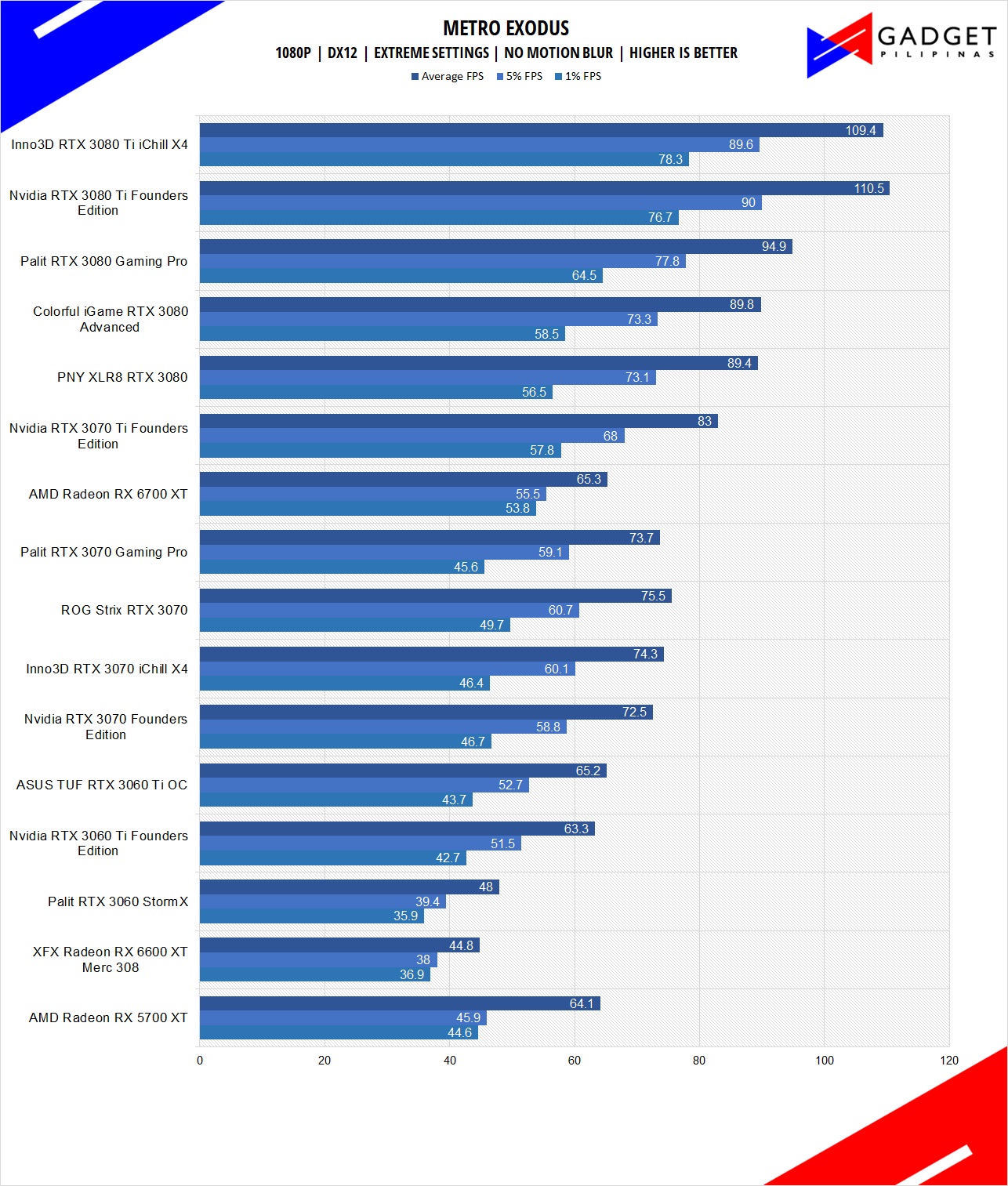
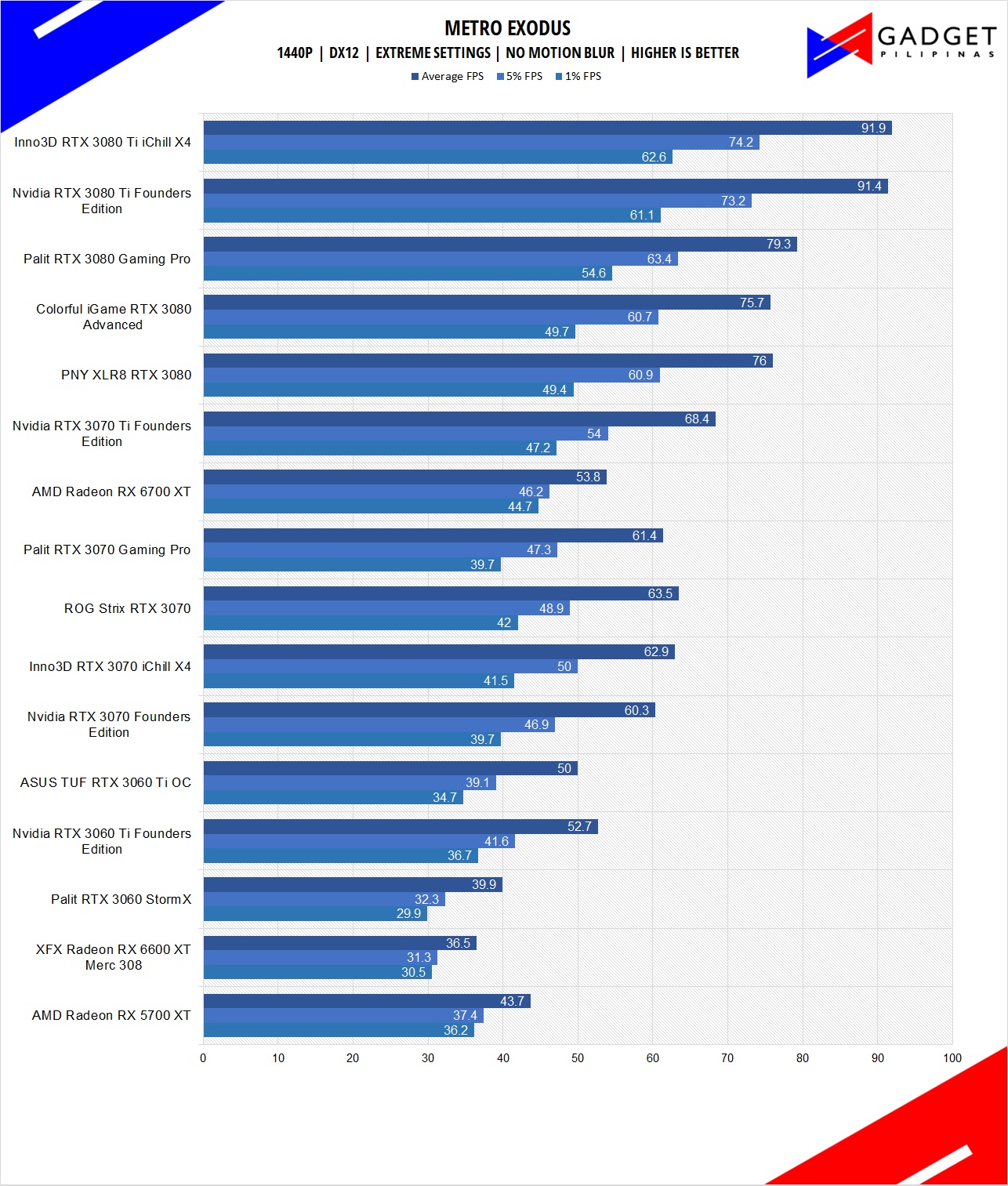
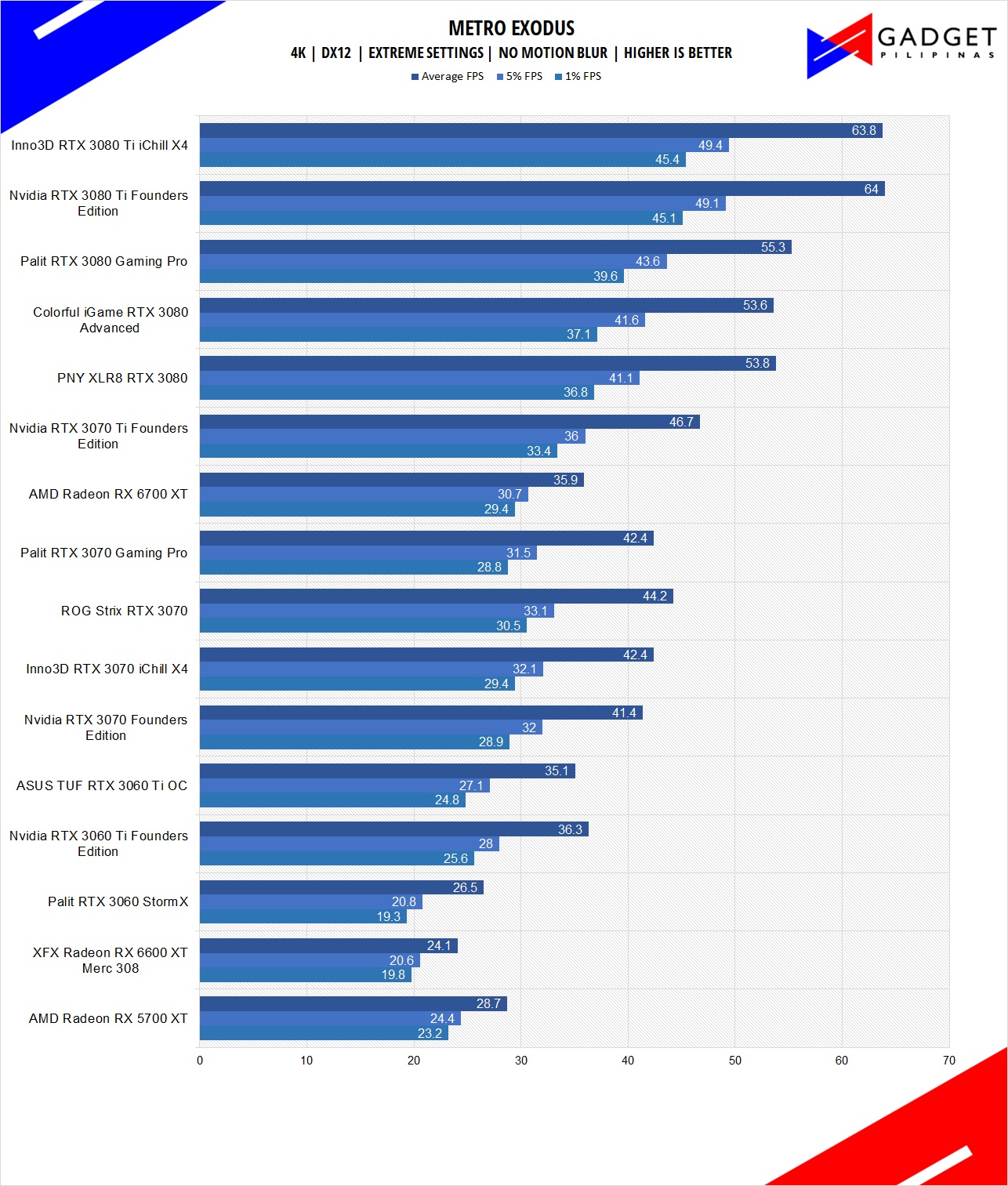 Metro Exodus is the third Metro game trilogy based on Dmitry Glukhovsky’s novels. The game is a first-person shooter with survival horror and stealth elements. The post-apocalyptic game uses 4A Engine by 4A games. Released last 2019, Metro Exodus remains to be one of the most graphically pleasing and demanding games that’s popular to date.
Metro Exodus is the third Metro game trilogy based on Dmitry Glukhovsky’s novels. The game is a first-person shooter with survival horror and stealth elements. The post-apocalyptic game uses 4A Engine by 4A games. Released last 2019, Metro Exodus remains to be one of the most graphically pleasing and demanding games that’s popular to date.
Assassin’s Creed: Odyssey
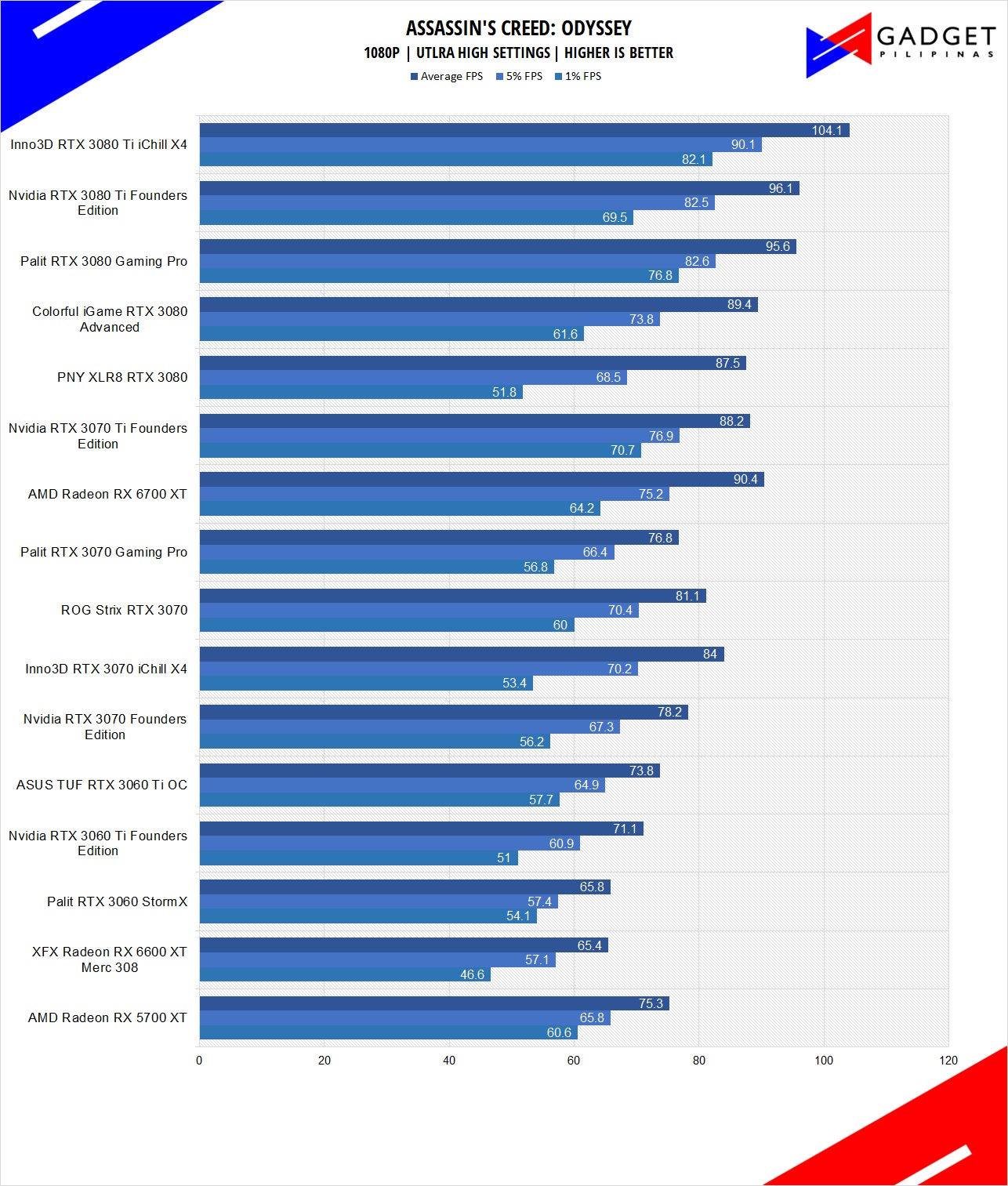
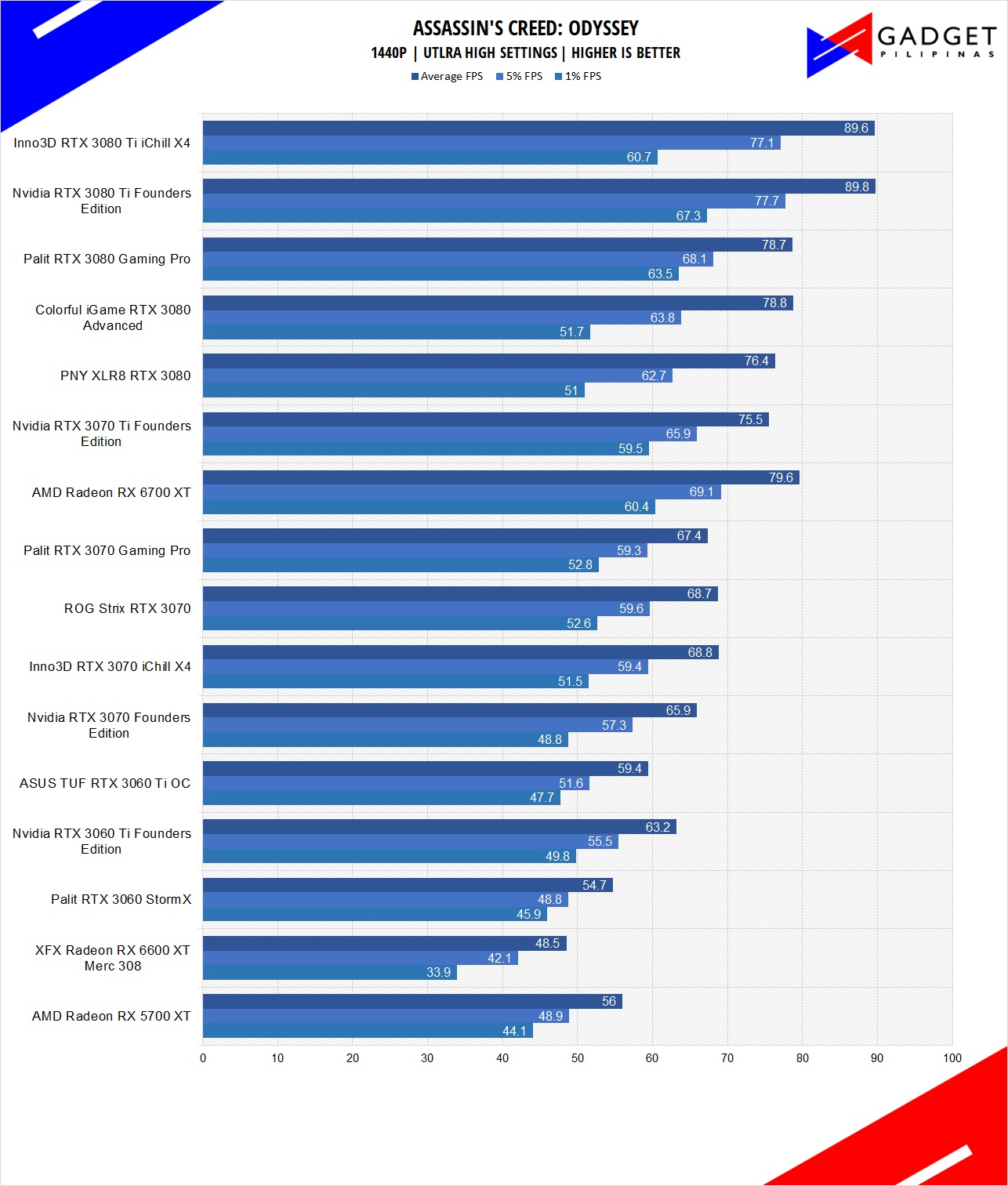
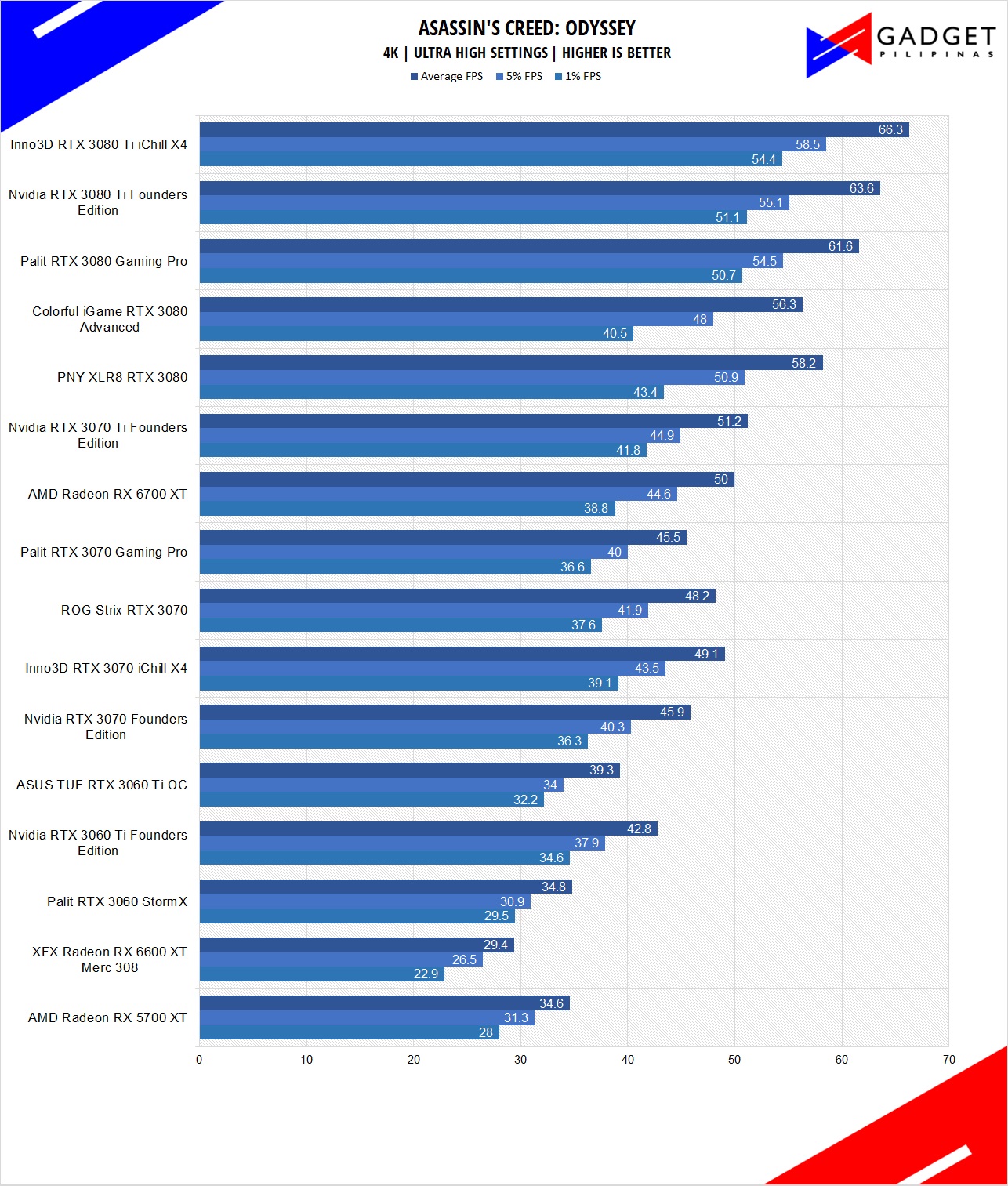 Assassin’s Creed Odyssey is the latest franchise installment from Ubisoft. It’s by far the most popular and stable Assassin’s Creed title since AC IV: Black Flag. It uses the AnvilNext 2.0 game engine, an updated version of Rainbow Six Siege’s game engine, and uses the DirectX 12 API.
Assassin’s Creed Odyssey is the latest franchise installment from Ubisoft. It’s by far the most popular and stable Assassin’s Creed title since AC IV: Black Flag. It uses the AnvilNext 2.0 game engine, an updated version of Rainbow Six Siege’s game engine, and uses the DirectX 12 API.
F1 2020
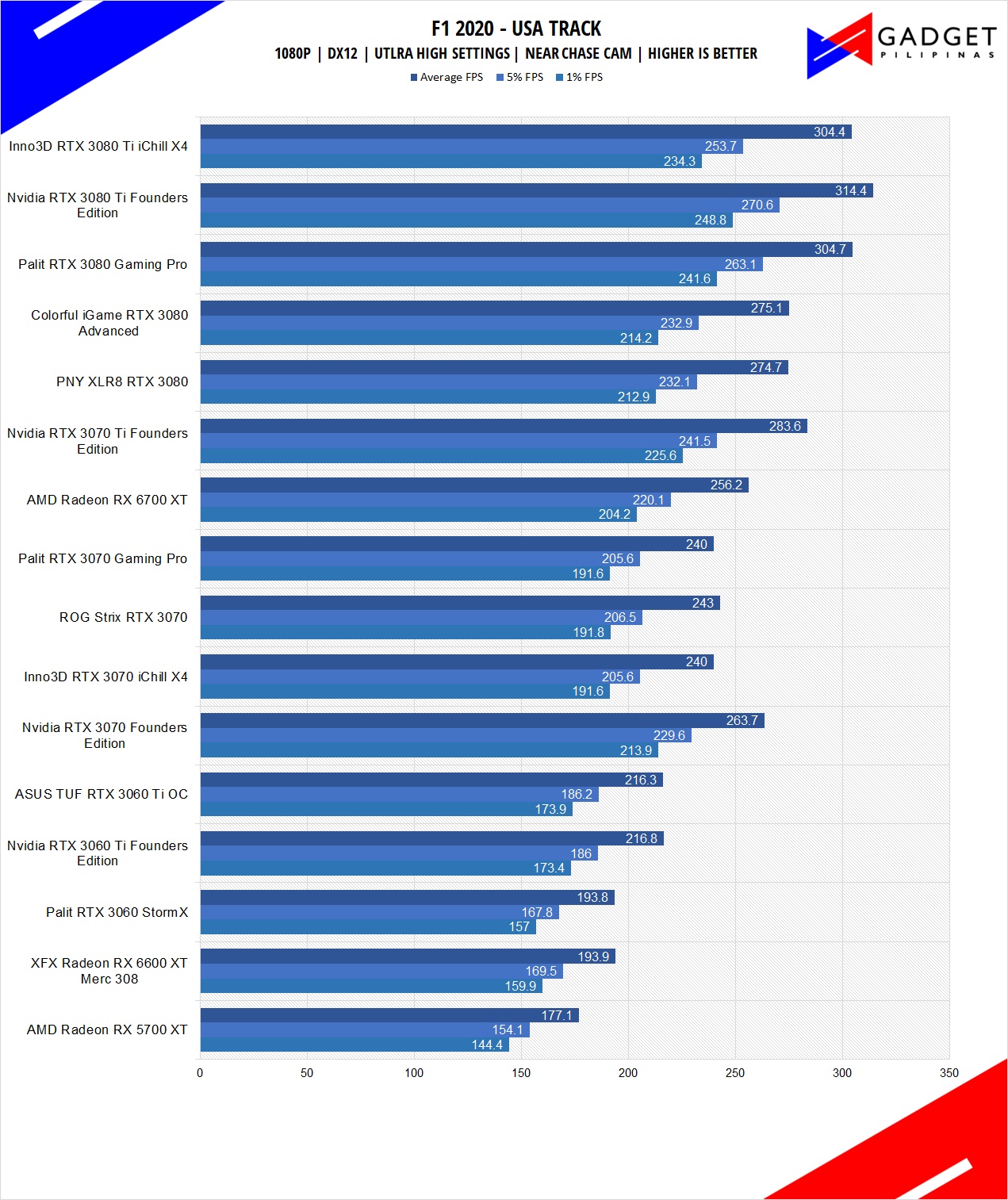
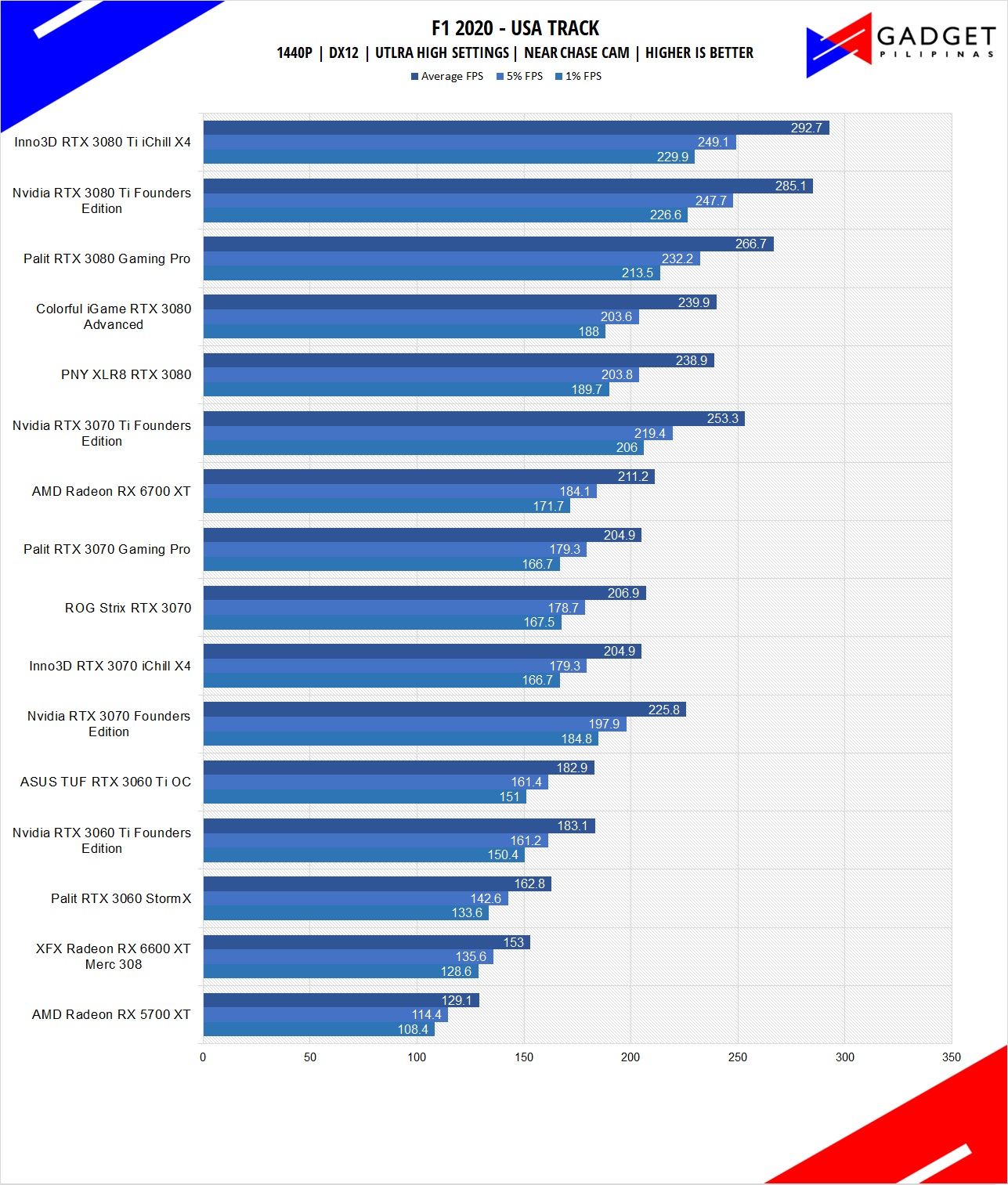
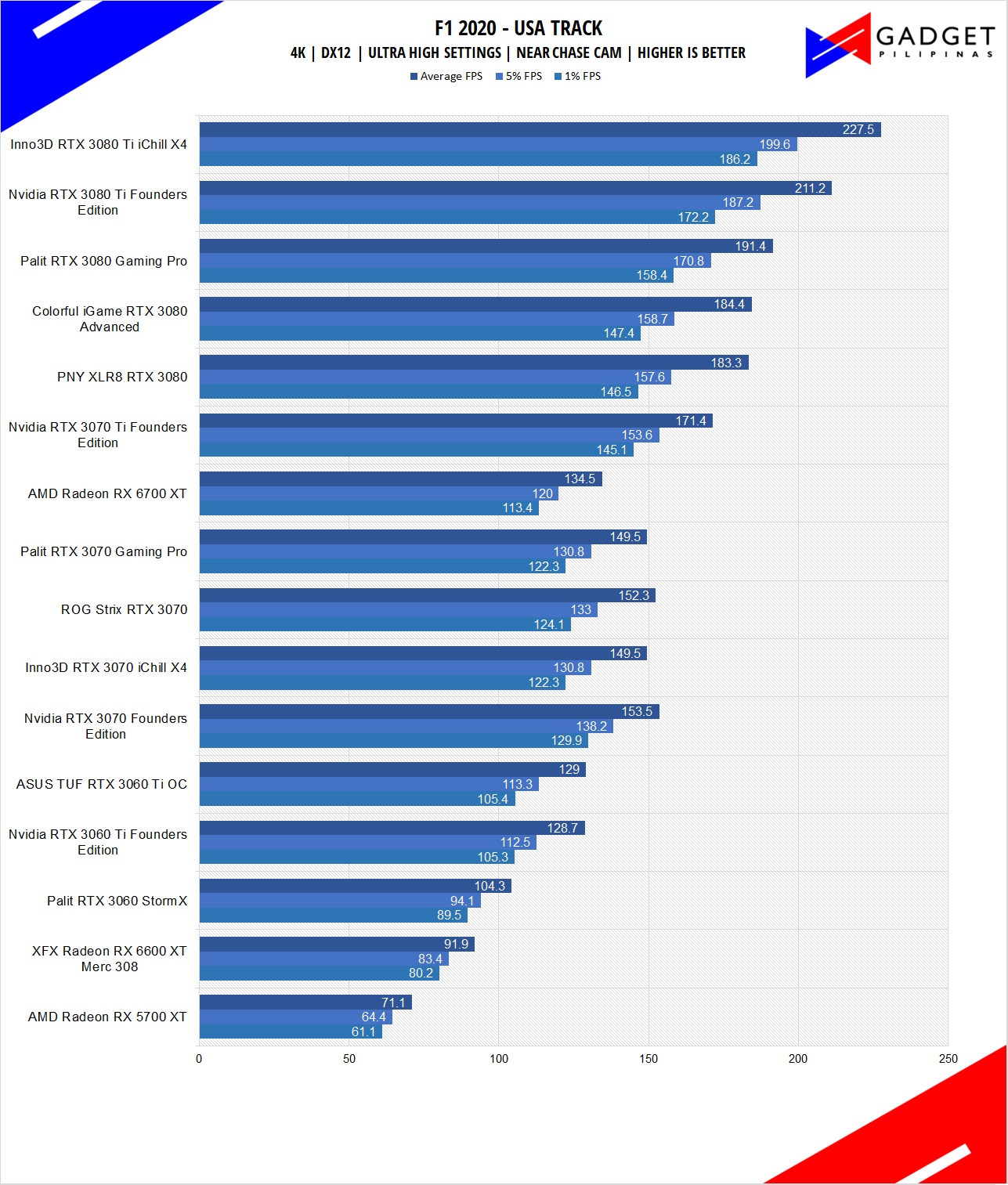 F1 2020 is the official video game of the 2020 Formula 1 and Formula 2 championships developed by Codemasters. F1 2020 is the twelfth installment in the franchise and uses the Ego Engine 3.0. F1 2020 is a good representation of racing games thanks to its realistic graphics and fairly demanding spec requirements.
F1 2020 is the official video game of the 2020 Formula 1 and Formula 2 championships developed by Codemasters. F1 2020 is the twelfth installment in the franchise and uses the Ego Engine 3.0. F1 2020 is a good representation of racing games thanks to its realistic graphics and fairly demanding spec requirements.
GODFALL
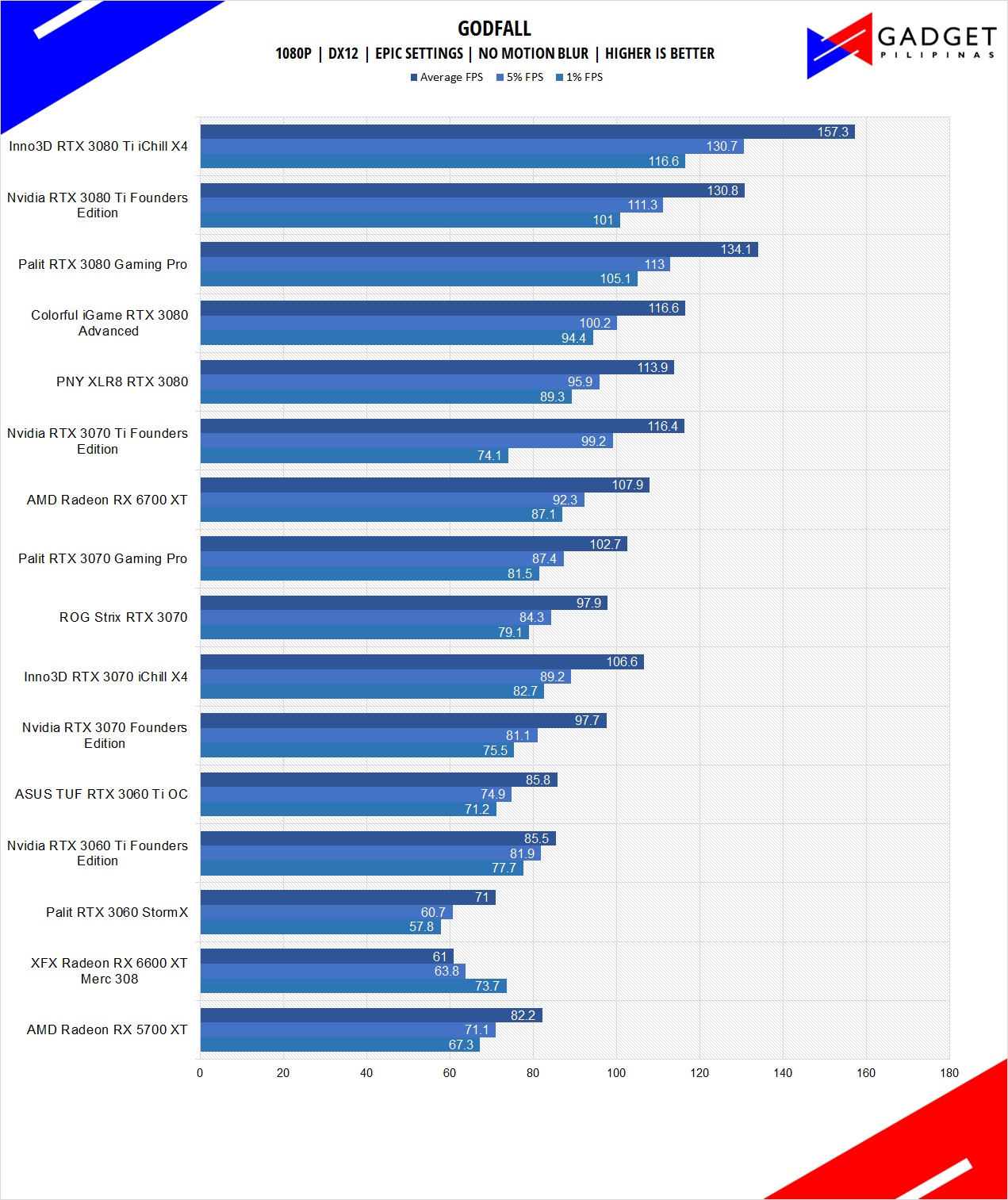
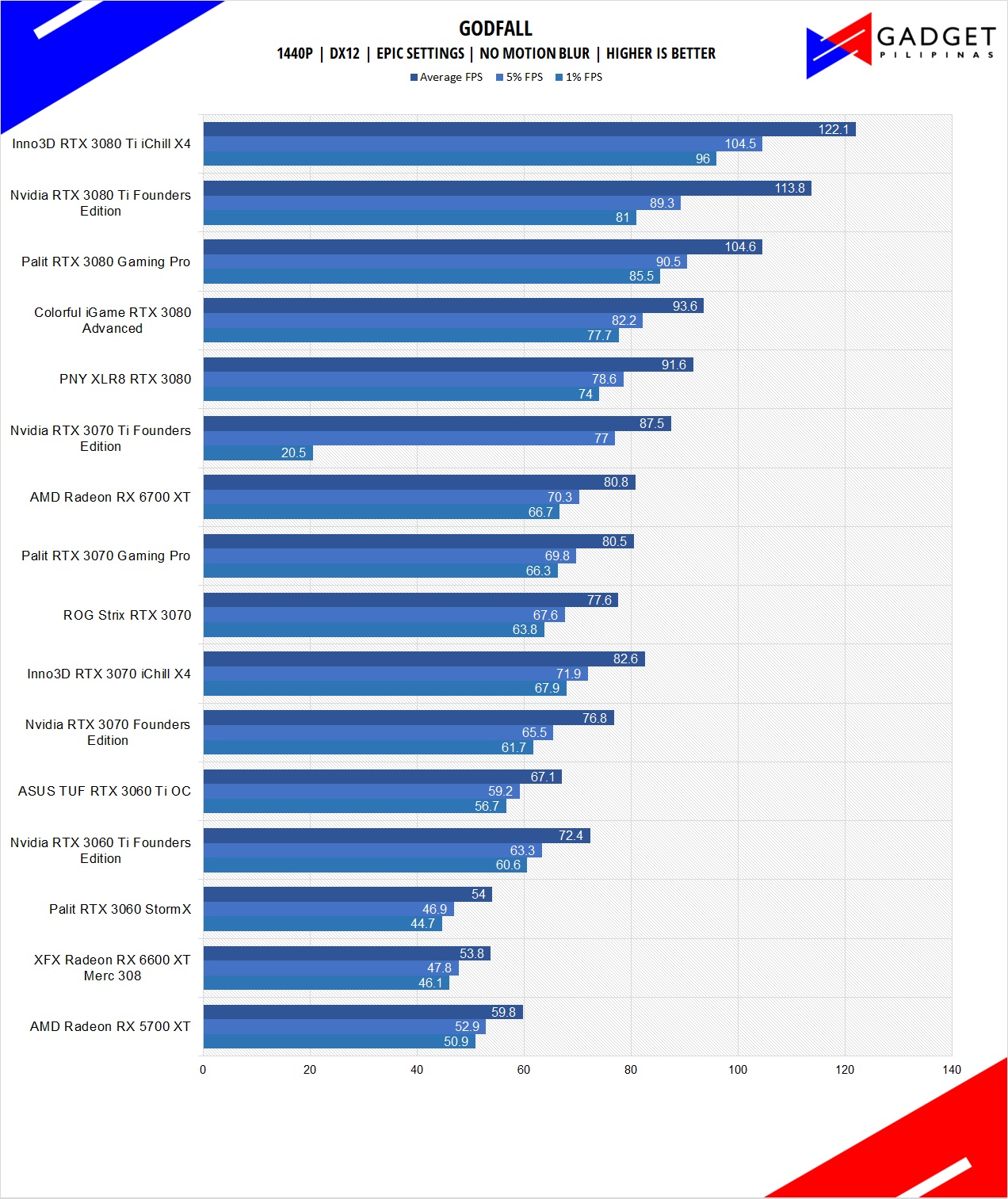
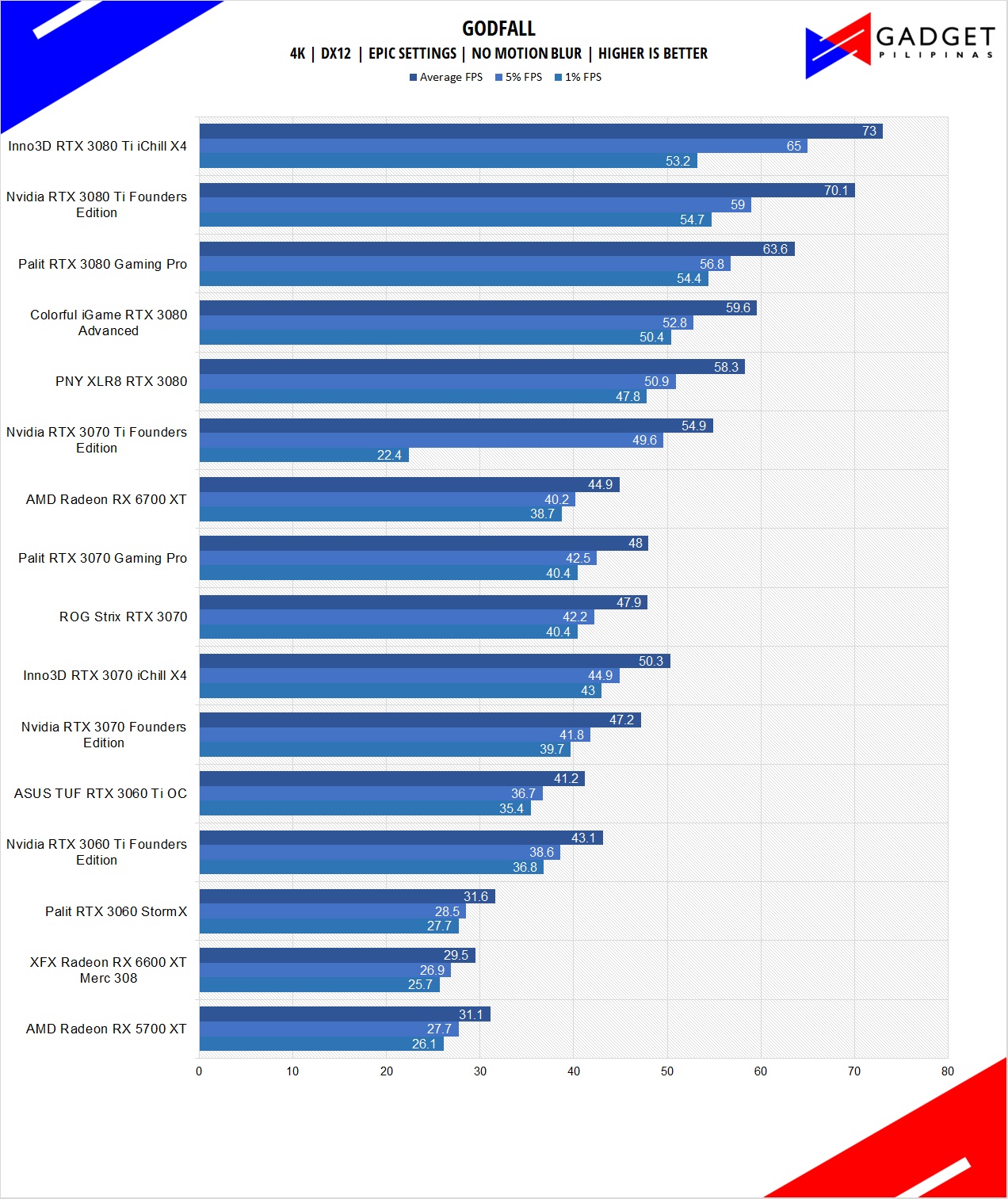 Godfall’s resolution performance scaling is impressive, considering this is launch performance numbers. Counterplay Games plans to release a ray tracing setting for Godfall but will only be limited to AMD at launch. We plan to revisit Godfall once Ray Tracing is available on Nvidia for a fair comparison against Radeon graphics cards.
Godfall’s resolution performance scaling is impressive, considering this is launch performance numbers. Counterplay Games plans to release a ray tracing setting for Godfall but will only be limited to AMD at launch. We plan to revisit Godfall once Ray Tracing is available on Nvidia for a fair comparison against Radeon graphics cards.
Performance Summary
- ASUS ROG Strix RTX 3070 Review ROG RTX 3070 1080p benchmark
- ASUS ROG Strix RTX 3070 Review ROG RTX 3070 1080p benchmark
- ASUS ROG Strix RTX 3070 Review ROG RTX 3070 1440p benchmark
- ASUS ROG Strix RTX 3070 Review ROG RTX 3070 1440p benchmark
- ASUS ROG Strix RTX 3070 Review ROG RTX 3070 4k benchmark
- ASUS ROG Strix RTX 3070 Review ROG RTX 3070 4k benchmark
Performance on 1080p resolution was not favorable for the ASUS ROG Strix RTX 3070 as it generated the lowest numbers across our whole RTX 3070 lineup. However, as we bump up the resolution, the rest of the cards suffer a considerable drop in frame rates. In contrast, the ASUS ROG Strix RTX 3070 suffers the most negligible reduction in FPS(vs. 1080p), and it manages to output a more stable framerate as represented by our 5% and 1% FPS.
ASUS ROG Strix RTX 3070 Temps and Power Draw
- ASUS ROG Strix RTX 3070 Review ROG RTX 3070 Power Draw
- ASUS ROG Strix RTX 3070 Review ROG RTX 3070 Power Draw
- ASUS ROG Strix RTX 3070 Review ROG RTX 3070 Temps
- ASUS ROG Strix RTX 3070 Review ROG RTX 3070 Temps
ASUS deserves high praise for maintaining a maximum recorded temperature of only 65°C on the ROG Strix RTX 3070 despite having the highest power draw of 277.9 watts across the whole RTX 3070 stack. The 65°C max temps clearly scream overkill for the newest ROG Strix cooler design as its using the same cooler as the ROG Strix RTX 3080 and RTX 3090. Moreover, the sub 70°c temps show a wide overclocking headroom of the ROG Strix RTX 3070, which will essentially solve the FPS deficit on 1080p resolution.
Conclusion
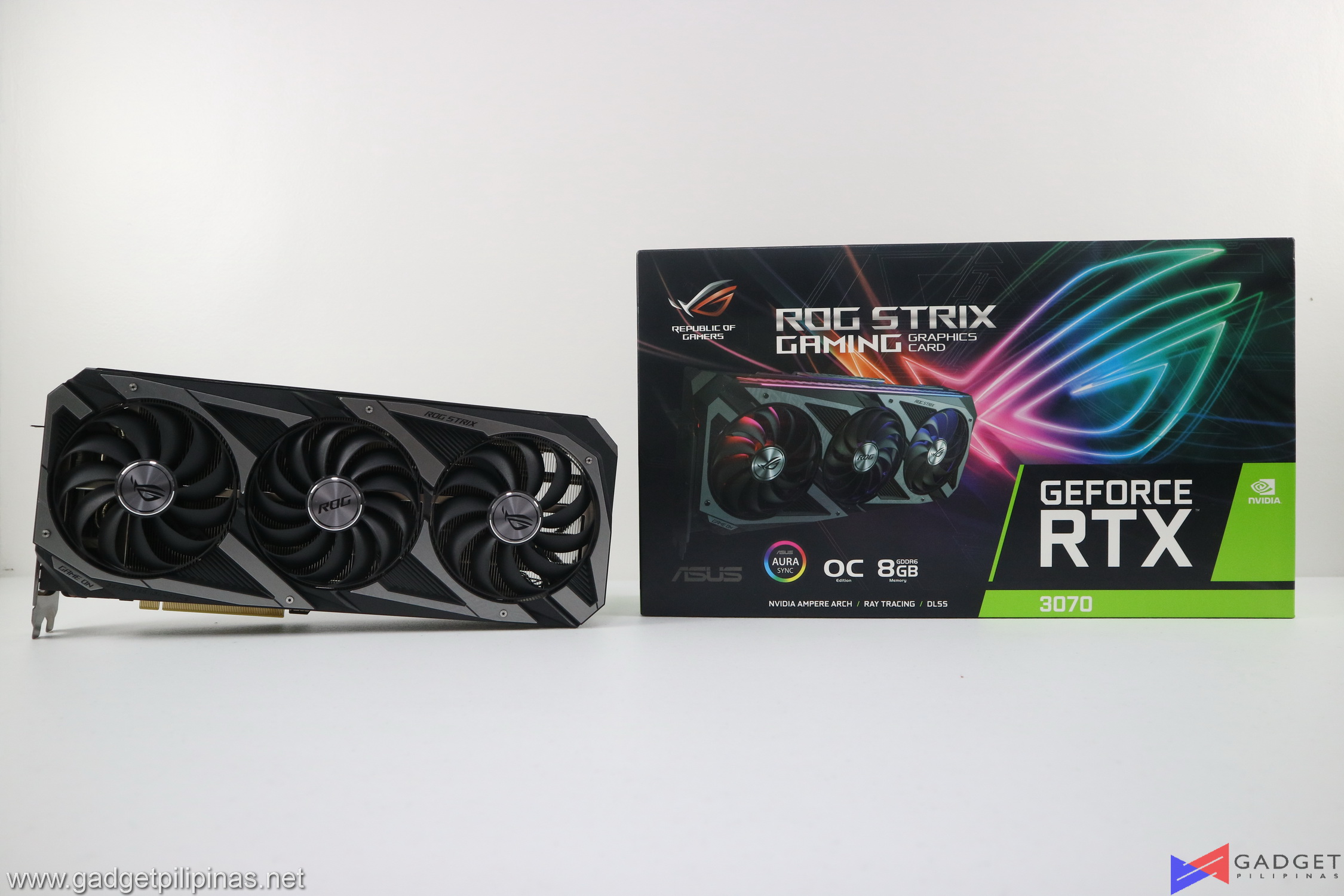
With all of the graphics cards we currently have(those shown in the benchmarks), nothing comes close to ASUS’ craftsmanship with the ROG Strix GeForce RTX 3070 graphics card. The ASUS ROG Strix RTX 3070 OC is arguably one of the most sleek-looking custom RTX 3070 GPUs, given its 2.9-slot profile. The revisions made from the previous ROG Strix cooler make the current ROG Strix RTX 30 graphics cards run at lower temperatures as exhibited by the ROG Strix RTX 3070’s 65°C max temperature, beating all of our RTX 3070s, not to mention other lower TGP graphics cards. However, all of that comes with a price, and that’s what the ROG Strix label demands as going for the ROG Strix variant will immediately land you near the cost of an RTX 3080 or RTX 3070 Ti. The question now arises if whether or not the premium is worth it. GPU shortage aside, the ASUS ROG Strix RTX 3070 is definitely worth the extra investment as it offers unmatched thermals, good overclocking headroom, excellent aesthetics, fluid RGB lighting, and superb build quality that comes with the ROG Strix brand. Bottom line, the ASUS ROG Strix RTX 3070 is a must purchase if thermals and build quality are your top priority in procuring a graphics card, provided you have the budget and case clearance to spare.
Grant is a Financial Management graduate from UST. His passion for gadgets and tech crossed him over in the industry where he could apply his knowledge as an enthusiast and in-depth analytic skills as a Finance Major. His passion allows him to earn at the same time help Gadget Pilipinas' readers in making smart, value-based decisions and purchases with his reviews and guides.

